Jessica Knauss's Blog, page 11
June 7, 2017
Valencia, City of Dreams Come True: The Trip of a Lifetime, Part 10
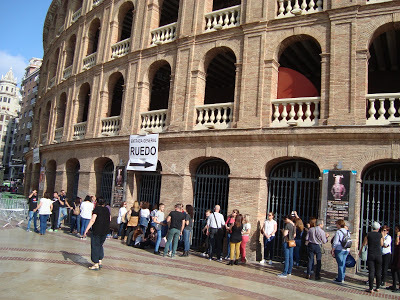 Line up here to stand in the sand!
Line up here to stand in the sand!Photo by Jessica Knauss Time moved strangely the afternoon of May 26, 2016, and Stanley and I quickly felt it was time to get back on the subway. We looked around at people—how many of them were going to the concert? When we got out at the bullring, a line had already formed with hundreds of people, enough to wrap around the bullring and down the street that’s between it and the train station. We’d been so nervous about being in such a big arena with so many people, but now that we weren’t going to have to wait in line at all I was even more nervous! The excitement of achieving this dream that had been so rudely snatched away from me!
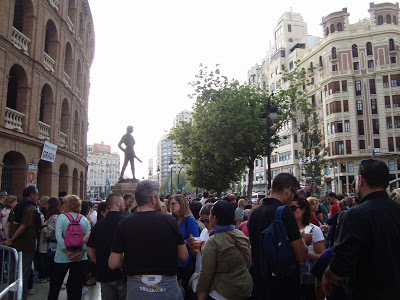 Just a few people in line. Photo by Jessica Knauss We went to the ticket booth area where we’d gone in before and called up our friend Marta. It was already much easier to do so; she started calling me guapa and I tried to pick up normal Spanish phone habits. Miguel, the bodyguard from before, came out to get us.
Just a few people in line. Photo by Jessica Knauss We went to the ticket booth area where we’d gone in before and called up our friend Marta. It was already much easier to do so; she started calling me guapa and I tried to pick up normal Spanish phone habits. Miguel, the bodyguard from before, came out to get us. “¿Qué tal?”
“¡Bien, muy bien!”
We went through the gate, as important as you please, this time going up the stairs to get into the tendido, the riser benches. Stanley had no interest in standing for five or six hours and I can't blame him. Miguel took us where he knew we would get the best seats. Wow, were they ever.
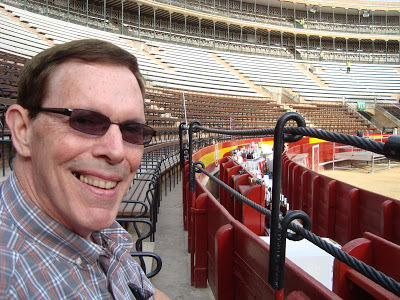 Still sunny and the place to ourselves, with the beverage station Miguel said we could sit anywhere we wanted in a certain section, then left to prepare to follow Manolo while he jumped around in the audience. (I’ve since seen him in videos and pictures, so serious! Oh, the questions I would’ve asked if I’d known exactly what he does.) We sat in the first row of benches, directly across from the stage, next to the front door opening where people come through to get into the sand. The only thing in front of us was railing to keep us from falling.
Still sunny and the place to ourselves, with the beverage station Miguel said we could sit anywhere we wanted in a certain section, then left to prepare to follow Manolo while he jumped around in the audience. (I’ve since seen him in videos and pictures, so serious! Oh, the questions I would’ve asked if I’d known exactly what he does.) We sat in the first row of benches, directly across from the stage, next to the front door opening where people come through to get into the sand. The only thing in front of us was railing to keep us from falling. The beverage people were set up at the barrier the bullfighters leap over when chased. They were getting briefed and psyched up and one of them asked is if this was going to be a private concert. We were the only people in the audience! How we were doing? he asked. Awesome, really. The anticipation was so sweet, we didn't even need any drinks.
An hour later, they started letting people in. They admitted groups in at different times, and so in spite of the long queue, the bullring filled slowly. The places next to Stanley and me filled right up because they were so desirable. Over the sound system, they started playing the first few songs from two albums, one by Carmen and one by Ricardo Marín. When the arena seemed about half full, Carmen walked through the sand. People were taking pictures with her and shouting her name from the tendido. “I didn’t know she was that recognizable,” Stanley said.
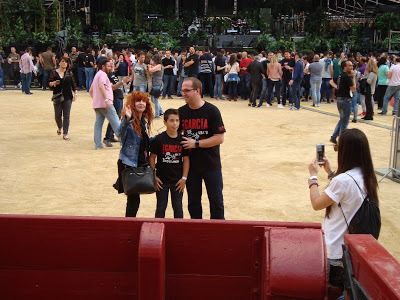 Carmen García with fans. Photo by Jessica Knauss The next time her album came on, I said, “That’s her!” When we listened to her album later, Stanley thought it was fantastic, and that it was kind of unfair to have so much talent in one family.
Carmen García with fans. Photo by Jessica Knauss The next time her album came on, I said, “That’s her!” When we listened to her album later, Stanley thought it was fantastic, and that it was kind of unfair to have so much talent in one family. 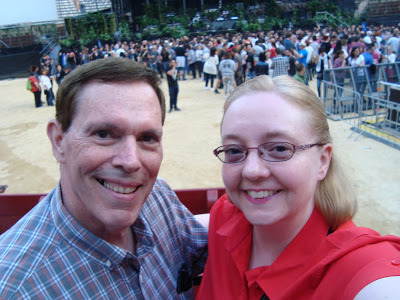 Great seats, oh yeah! Everyone was so happy—a true communal experience. A large beach ball made its buoyant way across the bullring. People were bursting out into flamenco clapping and doing the wave. As it got closer to the start of the show, some people did the “Man-O-lo” chant. A lone guy sat next to Stanley and sat there eating multicolored popcorn without offering any, and in the end he got really excited and was dancing, knocking Stanley’s cell phone so I had to use YouTube’s shakiness corrector when I uploaded the videos later. I waited until it seemed like everyone was in their place, and then visited the souvenir table.
Great seats, oh yeah! Everyone was so happy—a true communal experience. A large beach ball made its buoyant way across the bullring. People were bursting out into flamenco clapping and doing the wave. As it got closer to the start of the show, some people did the “Man-O-lo” chant. A lone guy sat next to Stanley and sat there eating multicolored popcorn without offering any, and in the end he got really excited and was dancing, knocking Stanley’s cell phone so I had to use YouTube’s shakiness corrector when I uploaded the videos later. I waited until it seemed like everyone was in their place, and then visited the souvenir table. 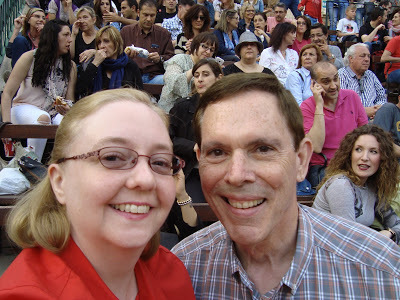 I looked over the merch and wanted everything, anything to feel as if I could take this happiness with me. Knowing that was impossible, I bought only five items, most amazingly, a demented lollipop. It’s the graphic from the cover of
Todo es ahora
. When the album first came out, many talk show hosts guessed what the artwork was supposed to be, and in an interview with Manolo, Buenafuente guessed, “It’s a demented lollipop.” Manolo said, “That must be it.” It struck me as hilarious.
I looked over the merch and wanted everything, anything to feel as if I could take this happiness with me. Knowing that was impossible, I bought only five items, most amazingly, a demented lollipop. It’s the graphic from the cover of
Todo es ahora
. When the album first came out, many talk show hosts guessed what the artwork was supposed to be, and in an interview with Manolo, Buenafuente guessed, “It’s a demented lollipop.” Manolo said, “That must be it.” It struck me as hilarious. 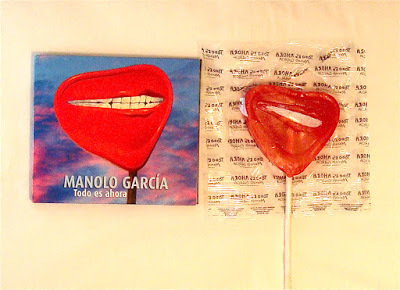 Demented lollipops!! I got back in plenty of time, exhilarated with my booty and with the fact that this thing was happening! No gumption trap, no distance, and no petty thief managed to get in my way.
Demented lollipops!! I got back in plenty of time, exhilarated with my booty and with the fact that this thing was happening! No gumption trap, no distance, and no petty thief managed to get in my way.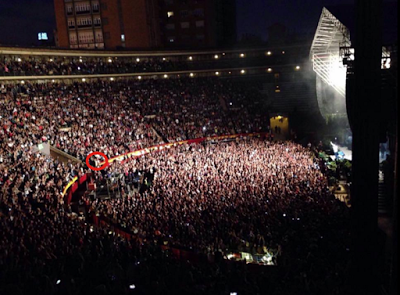 Can you find us? It's filled to the rafters! It started with a surrealist film featuring a lot of eggs and some chickens. Mass production and nature contrasted in the scenery. Then the lights go low and the American musicians come out and play a long, almost psychedelic introduction, during which the man himself walks out with no lights on him and stands stock-still until you think you can't stand it anymore, until just the right moment.
Can you find us? It's filled to the rafters! It started with a surrealist film featuring a lot of eggs and some chickens. Mass production and nature contrasted in the scenery. Then the lights go low and the American musicians come out and play a long, almost psychedelic introduction, during which the man himself walks out with no lights on him and stands stock-still until you think you can't stand it anymore, until just the right moment. 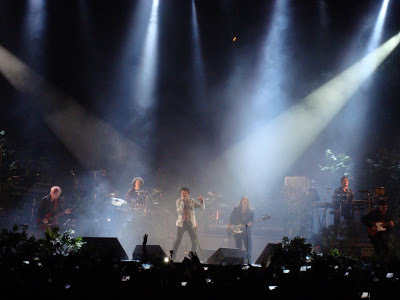 "¡Tú me obligaste a sentirme bien en soledad!" Heaven in Valencia.
"¡Tú me obligaste a sentirme bien en soledad!" Heaven in Valencia.Photo by Jessica Knauss Then it all happens: lights, music, Manolo’s voice—“Tú me obligaste a sentirme bien en soledad”—with a rock-star swing of the mic stand and stamp of the feet. It was everything coming together in the right place at the right time. Stanley said it was an effective opening because when Manolo started to sing, a tear came to Stanley’s eye. I was so touched that the moment meant so much to both of us. I hadn’t been the biggest fan of that first song, but after seeing this, I recognize its amazing qualities. For instance, it hits the sweet spot in Manolo's voice over and over. Or maybe they’re all the sweet spot!
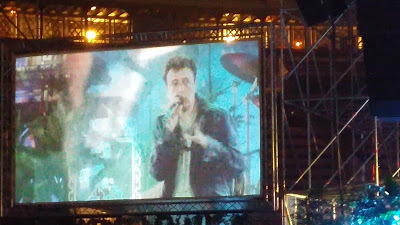 The sound was incredible at our seats. We were all, thousands of people, submerged in this experience, without it hurting our ears. I couldn’t hear people singing along like you can in the YouTube cell phone videos afterward. I found myself singing along—it was an obligation!—and cheering and shouting and all the algarabía de alegría. A wonderful loss of control, a surrender to the moment. Stanley and I got to sit there with no one standing in our way. We took some videos with the sensation simultaneously that the moment was eternal and that we needed to record everything because its end was imminent. And that they were the best videos ever taken at any concert, except for the fact that Manolo likes to go off randomly into the crowd. It’s terribly exciting, but you can’t follow him with the camera to save your life! Sweet madness. Sometimes I would watch the moment and just hope the camera was capturing some of it.
The sound was incredible at our seats. We were all, thousands of people, submerged in this experience, without it hurting our ears. I couldn’t hear people singing along like you can in the YouTube cell phone videos afterward. I found myself singing along—it was an obligation!—and cheering and shouting and all the algarabía de alegría. A wonderful loss of control, a surrender to the moment. Stanley and I got to sit there with no one standing in our way. We took some videos with the sensation simultaneously that the moment was eternal and that we needed to record everything because its end was imminent. And that they were the best videos ever taken at any concert, except for the fact that Manolo likes to go off randomly into the crowd. It’s terribly exciting, but you can’t follow him with the camera to save your life! Sweet madness. Sometimes I would watch the moment and just hope the camera was capturing some of it. 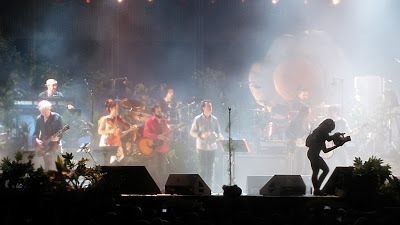 Here you can see the agile person dressed all in black who
Here you can see the agile person dressed all in black who captured images for the giant screens. With a lot of premeditation, thinking we would be last in line and up in the top gradas (nosebleed section), we’d brought binoculars from the States. I might have used them more if it hadn’t been a pain to take off my glasses and keep track of them while using the binocs. We didn’t strictly need the binoculars, in the end, because we were plenty close. Crazy Manolo was in good form—where does he get the energy? He threw the mic stand in the air. Stanley said he was going to get injured doing that kind of thing. But he’s been doing it for thirty years, so he understands the physics. Even some men were shouting “¡guapo!”
Manolo would often talk with the audience, and I think those were my favorite moments. Before “Estoy alegre,” he declared that being happy is the most important thing. There was a fireside chat about people with diseases you can’t see, and lots of current Spanish politics before “Subo escalas, bajo escalas.”
“All the good songs,” Stanley said at one point. And it’s true, song after song of wonderfulness, no clunkers ever, and what excellent playing, and that voice never even sounded tired.
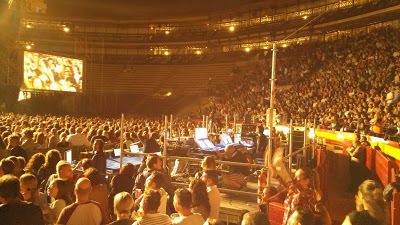 IntermissionDuring an intermission while they changed the set instruments, they showed pictures of the audience on the monitors with some kiss cam moments. I’m not sure how long it lasted, but people got clapping and chanting again, always wanting to see their Manolo. They don’t know he belongs to me and I was just lending him. (wink)
IntermissionDuring an intermission while they changed the set instruments, they showed pictures of the audience on the monitors with some kiss cam moments. I’m not sure how long it lasted, but people got clapping and chanting again, always wanting to see their Manolo. They don’t know he belongs to me and I was just lending him. (wink) 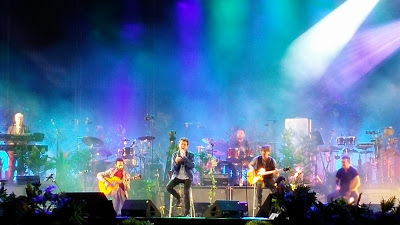 Starting the second half with the flamenco version of "En el batir de los mares"
Starting the second half with the flamenco version of "En el batir de los mares"complete with acoustic guitars and Juan Carlos García on cajón.
Photo by Stanley Coombs
The second half brought out the Spanish musicians who always tour with Manolo and are recognizable in their own right. It also featured the earlier albums and even a few old gems from before Manolo went solo. People can never get enough of their favorite old songs, it seems, so this was where people really lost it.
My favorite from before the latest album, "Rosa de Alejandría," surprised me because the audience went almost as crazy as I did for it. I had no idea it was one of those crowdpleasers. What a thrill to share my little song!
Before "Somos levedad," Manolo talked about how good it feels to sing, and oh did it ever, to sing the ahaaahaahahh part with thousands of people.
"Prefiero el trapecio" was the pretend end. Manolo introduced the band and said good night, and after a bit of screaming and chanting, he came back out and asked if we want more. “¿Seguuuuurrrrooooooos?” (Are you suuuurre?) We convinced him easily.
I tried to film "Sobre el oscuro abismo"—which I later found out has a verb conjugation error in it! But it was utter chaos with Manolo all over the crowd.
By the time they get to "Viernes," everyone was totally nuts, onstage and off. The backup singers took over the vocals for some of the song so Manolo could fly all over the place.
"A San Fernando" was an opportunity for massive improvised solos and general yelling and screaming that was completely different in every concert.
Oh, that there could be such joy in the world.
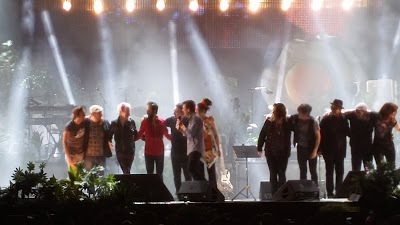 Taking their bows with a few laughs After more than three hours of music and several changes of shirts as Manolo soaked them through with sweat and passion, high on performance and possibly a little on the pot we smelled, Manolo brought both bands on the stage. They were being silly, and when people were already filing out, he gave his valediction, “¡Buenas noches, haced el amor!” (Good night, make love!) We were to see the same human being again in two days. What an amazing sensation, to be winding up the best thing you’ve ever done and know there’s more to come.
Taking their bows with a few laughs After more than three hours of music and several changes of shirts as Manolo soaked them through with sweat and passion, high on performance and possibly a little on the pot we smelled, Manolo brought both bands on the stage. They were being silly, and when people were already filing out, he gave his valediction, “¡Buenas noches, haced el amor!” (Good night, make love!) We were to see the same human being again in two days. What an amazing sensation, to be winding up the best thing you’ve ever done and know there’s more to come. 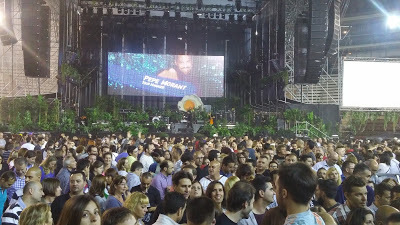 All these people left before we did. We had to wait to get out, and by the time we were on the street, all the taxis were gone from the stand. Stanley saw some people snagging the taxis farther up the street, which meant the people waiting to do it legit at the stand would be waiting a long time. So we went up even father than those naughty people and before I had time to think we would have to walk back, we were in a cab. Where were we going? Hmm… We were going the right direction, and we glimpsed the hotel out the window, and I said, there it is, and that was when the driver turned off to who knew where. Um, it’s back there. Sorry, sorry! We're just so tired. We walked into the lobby and there were people milling around, but it was quieter than anything before in the history of the world. We took sleeping pills, but I still don’t think I slept!
All these people left before we did. We had to wait to get out, and by the time we were on the street, all the taxis were gone from the stand. Stanley saw some people snagging the taxis farther up the street, which meant the people waiting to do it legit at the stand would be waiting a long time. So we went up even father than those naughty people and before I had time to think we would have to walk back, we were in a cab. Where were we going? Hmm… We were going the right direction, and we glimpsed the hotel out the window, and I said, there it is, and that was when the driver turned off to who knew where. Um, it’s back there. Sorry, sorry! We're just so tired. We walked into the lobby and there were people milling around, but it was quieter than anything before in the history of the world. We took sleeping pills, but I still don’t think I slept!And there you have it. I hope this suggests something about what it’s like to want something for a really long time, and get it, and have it be even better than you could've dreamed. It was that way when I met Stanley, too. I knew I wanted true love, but had no idea what it looked like until he showed me every minute of every day we were together.
We'd built up this high for the whole trip, and having reached the summit, it didn't come down until I was on the nasty plane rides home. I can see how the feeling might be addictive, and why some people go to every concert they can.
Next time: Sevilla! Three loves in one place! Another unique concert!
Catch up with the rest of the posts in this series here.
Published on June 07, 2017 00:30
June 5, 2017
Valencia, Where the Oranges Come From: The Trip of a Lifetime, Part 9
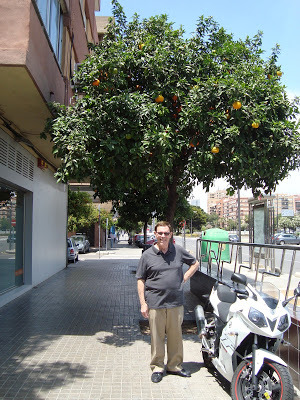 Valencia is where the oranges come from. This post and the following two contain extreme instances of joy. It is hard to write about joy unironically in English. Please bear with me while I labor to find appropriate words.
Valencia is where the oranges come from. This post and the following two contain extreme instances of joy. It is hard to write about joy unironically in English. Please bear with me while I labor to find appropriate words. Our first day in Valencia was very glamourous. We dropped off our clothes at a cleaner. We'd only packed enough for half the trip, and had meant to get the wash done in Barcelona, or Morella, or Peñíscola. Valencia was our last chance before utter stinkage. The cleaner was cheaper than hotel service and there is no place to do your own laundry. Believe me, we looked.
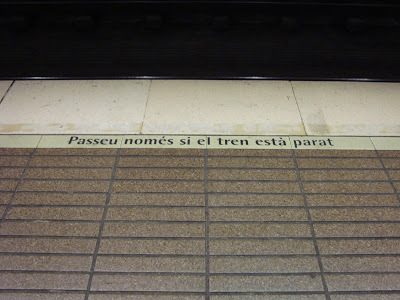 Don't cross (the line) unless the train is stopped. Valencian language in action! Valencia has its own language, which has a lot of similarity to Catalan, but the speakers have a much more casual approach to it. I didn’t hear much of it spoken, just the written signage and place names, even there in the language's capital.
Don't cross (the line) unless the train is stopped. Valencian language in action! Valencia has its own language, which has a lot of similarity to Catalan, but the speakers have a much more casual approach to it. I didn’t hear much of it spoken, just the written signage and place names, even there in the language's capital. We decided to check out the bullring, the site where all my dreams would come true because we had tickets to a Manolo García concert there for the very next day! We always liked the train, so we flaunted everyone's advice to take the bus, only to find out that the last metro left from the bullring at 11:31 p.m. on Thursdays. That sounded much too early to enjoy the entire concert, and we racked our brains about what to do even as we traveled.
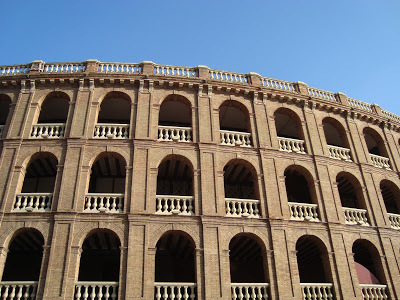 Photo by Jessica Knauss You come out of the station and the bullring is right there. It’s a lovely red brick structure, and from the outside it gives a great colosseum impression. And we heard Manolo García's crew doing sound tests! Hola hola, un dos tres… We knew already that the stage would be decorated with thousands of plants and greenery—Manolo's way of calling attention to how little we see of living things in our daily lives. We could see in one of the doors and they were setting up the plants already! I started to fully realize that this thing was going to happen. We hung out a bit, and people passed by asking what was going on. "Mañana, Manolo García, sí sí!" I answered. What a thrill to have people know who I was talking about—and be obviously excited about it!
Photo by Jessica Knauss You come out of the station and the bullring is right there. It’s a lovely red brick structure, and from the outside it gives a great colosseum impression. And we heard Manolo García's crew doing sound tests! Hola hola, un dos tres… We knew already that the stage would be decorated with thousands of plants and greenery—Manolo's way of calling attention to how little we see of living things in our daily lives. We could see in one of the doors and they were setting up the plants already! I started to fully realize that this thing was going to happen. We hung out a bit, and people passed by asking what was going on. "Mañana, Manolo García, sí sí!" I answered. What a thrill to have people know who I was talking about—and be obviously excited about it! 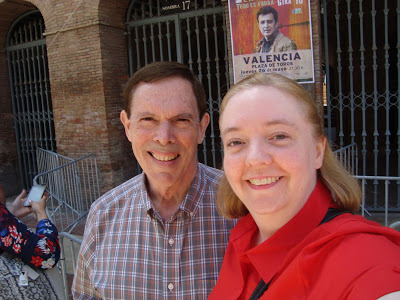 The excitement builds... Our most memorable meal in Valencia happened that evening at the Burger King. It was our cheapest meal of the trip, and we were both impressed with the one guy working at the entire restaurant. His name was Gonzalo, like two of the good guys in Seven Noble Knights. He never lost his cool even though he was doing everything, from taking orders to wiping down the entire place, to making drink and dessert orders and ferrying them to tables. I couldn't take my eyes off him because he looked familiar. "He looks just like Jude Law," Stanley said. He really did.
The excitement builds... Our most memorable meal in Valencia happened that evening at the Burger King. It was our cheapest meal of the trip, and we were both impressed with the one guy working at the entire restaurant. His name was Gonzalo, like two of the good guys in Seven Noble Knights. He never lost his cool even though he was doing everything, from taking orders to wiping down the entire place, to making drink and dessert orders and ferrying them to tables. I couldn't take my eyes off him because he looked familiar. "He looks just like Jude Law," Stanley said. He really did. The next morning, we were talking about how we should rest up and when we should retrieve our laundry… and I got an email from Carmen! She told us Manolo wanted to invite us to the sound check that day and ... greet each other, if I'm translating literally. I couldn't fathom the meaning of the phrase because my mind wasn't capable of imagining something so simple and so wonderful. Of course this threw everything into nervous panic happiness mode. I wrote that we would be there and wait for someone to tell us where to go, and she wrote back giving me the phone number of a Marta, who would tell us.
I read this as we should call when we got to the bullring, but Stanley wanted to avoid using the cell phone because of reasonable money concerns. We tried to use the hotel phone, only to find that we couldn't get an outside line. Calling people I don't know terrifies me, and doing so in Spanish only compounds the issue, and now I was using the cell phone and would have to keep it short? I screwed up my courage with a little tough love from Stanley (“Do you want this to happen? It’s going to be worth it!”). When she picked up, I said, “Hola Marta, soy Jessica, la chica de Estados Unidos.” She took it from there. She’s Manolo’s manager in the sense of getting his movements and welfare organized, and there’s no way anyone else in such a position would be so kind to fans. She told me to be at the bullring at 1 p.m. and call her so she could send someone to pick us up to take us inside. The emotions of these moments: surprise, joy, nerves, uncertainty blessed with a sense of adventure… We were supposed to pick up our laundry that afternoon, but we guessed we’d have to do it after we freaking met Manolo García! Besides, we were both wearing new clothes saved for just such an occasion.
We used our award-winning-design metro pass to get to the bullring like we’d already practiced. I felt an unfamiliar sense of privilege descend over us. We were traveling into a different reality. Never before had life seemed so right, so much as if we were in the right place at the right time, as if we mattered in the world.
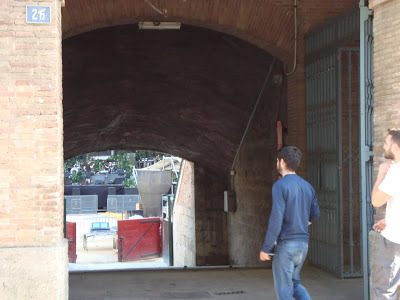 Tantalizing glimpses. Photo by Jessica Knauss We stood at Door 19, which is across from the stage, and listened to the Spanish musicians do another sound check. (This tour had two halves, one with an American band of heart attack–inducing fame, but they must've finished already.) There were a few other people hanging around outside. I called Marta as soon as we got there and she said something about she and Manolo not having arrived yet. So we waited and hoped she would call back. Song after awesome song rang out, instrumental and sometimes with the band filling in the vocals. I held Stanley close to me and tried not to strangle him with my excitement.
Tantalizing glimpses. Photo by Jessica Knauss We stood at Door 19, which is across from the stage, and listened to the Spanish musicians do another sound check. (This tour had two halves, one with an American band of heart attack–inducing fame, but they must've finished already.) There were a few other people hanging around outside. I called Marta as soon as we got there and she said something about she and Manolo not having arrived yet. So we waited and hoped she would call back. Song after awesome song rang out, instrumental and sometimes with the band filling in the vocals. I held Stanley close to me and tried not to strangle him with my excitement. “I used to listen to this album on repeat when I was working at the Boston University library,” I explained, and then, “This album was on repeat while I worked on my Iowa thesis... studying in Salamanca...” and of course, all of them were on repeat in the car with Stanley! These songs define a life. Hearing them live, even without Manolo's unique voice, brought memories rushing to the surface.
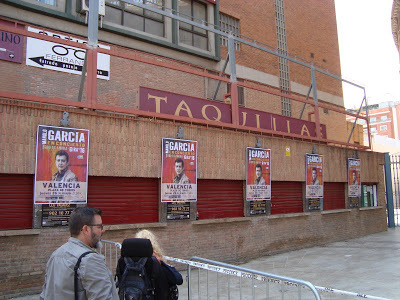 Waiting by the ticket booths. Photo by Jessica Knauss I don’t know how long we waited, but in the end Stanley’s phone missed a couple of calls, and finally I called Marta back (the cost, the cost!) and she told us to go to the gates near the ticket booths, and someone would come for us. We waited there a while longer, and finally here came a burly guy who was born to be a bodyguard, whose name, I would later find out, was Miguel. We came through the barrier under the astonished looks of other people hanging around, and Miguel was asking us how we were doing, and I translated for Stanley, and “bien” didn’t begin to cover it.
Waiting by the ticket booths. Photo by Jessica Knauss I don’t know how long we waited, but in the end Stanley’s phone missed a couple of calls, and finally I called Marta back (the cost, the cost!) and she told us to go to the gates near the ticket booths, and someone would come for us. We waited there a while longer, and finally here came a burly guy who was born to be a bodyguard, whose name, I would later find out, was Miguel. We came through the barrier under the astonished looks of other people hanging around, and Miguel was asking us how we were doing, and I translated for Stanley, and “bien” didn’t begin to cover it. 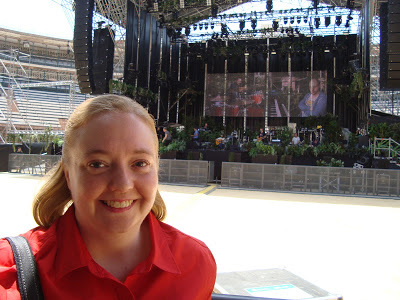 Have I entered an alternate universe of happiness? Oh, the giddy sense of … not quite anticipation because who knew what was going to happen? We were at a Manolo García sound check! I never imagined I would be somewhere so wonderful in my life. We met Marta in the hallway (the outer circle of the bullring) and she hugged and kissed us and seemed just as nice as on the phone. Miguel walked us out onto the sand and put us in the shade on the edge of the sound and light boards setup. I was just kind of smiling at everybody and the musicians were hacking away at songs I’ve known like the back of my hand for years and years. Lots of people rushing around, testing the video monitors, and a sense of when is he coming? When is he getting here? Carmen, from the emails, came by and kissed us both and I said, “So happy to meet you,” while Stanley was disconcerted beyond belief. “That was Carmen!” I told him after the fact. He was astounded that I would know her by sight, and I realized I hadn't told him that Manolo’s sister is also a recognizable performer.
Have I entered an alternate universe of happiness? Oh, the giddy sense of … not quite anticipation because who knew what was going to happen? We were at a Manolo García sound check! I never imagined I would be somewhere so wonderful in my life. We met Marta in the hallway (the outer circle of the bullring) and she hugged and kissed us and seemed just as nice as on the phone. Miguel walked us out onto the sand and put us in the shade on the edge of the sound and light boards setup. I was just kind of smiling at everybody and the musicians were hacking away at songs I’ve known like the back of my hand for years and years. Lots of people rushing around, testing the video monitors, and a sense of when is he coming? When is he getting here? Carmen, from the emails, came by and kissed us both and I said, “So happy to meet you,” while Stanley was disconcerted beyond belief. “That was Carmen!” I told him after the fact. He was astounded that I would know her by sight, and I realized I hadn't told him that Manolo’s sister is also a recognizable performer. 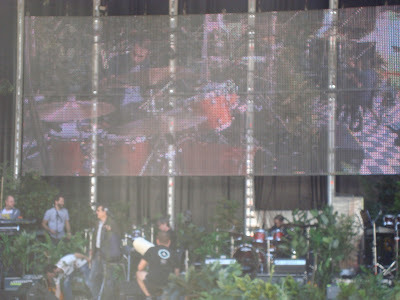 Manolo García gives direction at the sound check, fourth from left,
Manolo García gives direction at the sound check, fourth from left, wearing sunglasses. Photo by Jessica Knauss The murmurs began—He’s here. He’s in the building. A hush descended, overlaying the music. All six or seven of my bodily senses were attuned inexorably toward joy. Then suddenly Manolo, the man himself, an honest-to-God human being with the aura of a hundred angels, came onstage, just walking in like no big deal. He hung out with the backup singers on the side while they practiced "Una tarde de sol," then weaved around the instruments in the back, and came to the lip of the stage. With a big smile I had never seen in publicity photos, he gave us a big wave.
It was an arrow of gladness through my heart. This would have been enough, and this just the first thing. Someone, probably Marta, had told Manolo García where we were and we occupied some tiny part of his brain space. Stanley and I waved back, and our smiles would have blinded anyone who was already smile-blind.
A short time later, the sound check was over. Guitarist Ricardo Marín came down off the stage and exited through the front door, and the other musicians were clearing out. This is hard to describe because the whole world seemed to be on fire with joy. Who cared that it was late for lunch and everyone had an empty tummy? No one.
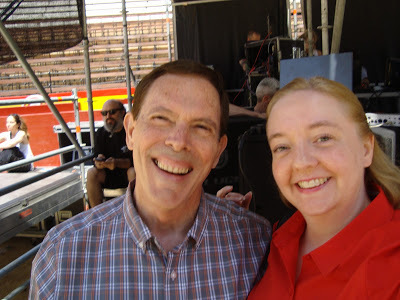 Where we belonged I tried to figure out the moment when my reality broke in two and I officially entered this alternate universe in which such wonderful things are not only possible or likely but actually took place. This may be it: before the other musicians were quite gone, Manolo came down off the front of the stage and started walking toward us. Manolo García braved the blazing sand wearing dark sunglasses and arrived at the sound/light boards barrier in front of us.
Where we belonged I tried to figure out the moment when my reality broke in two and I officially entered this alternate universe in which such wonderful things are not only possible or likely but actually took place. This may be it: before the other musicians were quite gone, Manolo came down off the front of the stage and started walking toward us. Manolo García braved the blazing sand wearing dark sunglasses and arrived at the sound/light boards barrier in front of us. I had been hoping for the Southern European greeting of the two kisses on the cheek, I will freely admit. But he reached across and gave us both American-conscious handshakes. His hand was so soft! Silk, butter, velvet, I’m not sure evoking something unalive is appropriate for this vital being. The first amazing eloquent thing out of my mouth was, “¿Qué tal?” (How are you?) in a pitch I remember as too high. After greetings, with a warning that his English was not up to scratch, he started right in reviewing the first letter I wrote to him back in 2008. While I was paying attention, and even responded in Spanish, describing how I was in Spain without Stanley and someone stole everything important that I had, I had trouble believing that Manolo García had devoted any memory space to my little story, but the incontrovertible evidence was right there before me in the speech, the animated expression, and most of all, those eyes.
Normal brown eyes more than 50 percent of the Earth’s population has, I’m sure he would protest. But that’s because he appears to have no notion of his own charisma or the effect he has on people. So much sincerity. Authenticity abounded. Here was a person who transmitted all his inner workings—his soul, if you will—through those humble brown eyes. And what a soul. Existing within that gaze was like being captured and cradled in a bubble made of energy I can’t describe except to say that it felt eerily similar to a blissful, life-saving dream I'd had ten years before. Just plain fantastic. A real dream come true. Remind me to tell you about that dream some time.
Maybe I’m just an overly sensitive fan girl. Is this what all big fans feel? They say you shouldn’t meet your heroes, but wow, this guy was the opposite of a disappointment. One of the lines from “Campanas de libertad,” from his last album, says, “Life bursting forth exultant, I'm not going to disappoint you.” Prophetic.
When the 2008 story reached a pause, he said, “Well, that’s in the past.” His last album title, Todo es ahora , translates to “Everything is Now.” Eckhart Tolle spent time in Spain, too. Those two gurus were in the same country. Imagine that hypothetical conversation.
Manolo directed the questions at us. How did we like Spain (love it), how many times had we been (Stanley 3, me 10), and where had we been on this trip. I said we’d gone through Barcelona. Oh, those windows to his soul widened. “Did you like it? That’s my city,” he said.
Stanley wasn’t too keen on Barcelona. We were still feeling some disappointment about Park Güell on the last day and Morella and Peñiscola had gone so much better, but my husband's customer service skills kicked in. “We loved it,” he said. It made me so happy.
Why was no one filming this whole thing? Even in the moment, I wanted to capture it forever, because come on, when will something like this ever happen again? I was so thrilled to see my two living true loves talking together like buddies, and I felt the moment was right, so I said, “¿Os saco una foto?” (May I take a picture of you two?)
We moved around so we were all on the same side of the barrier, the sand side, not the sound board side. I was keen to get the two guys together, but Stanley took the camera to get me and Manolo first. He was wearing one of those lovely shirts he wears that I wanted to buy for Stanley. I was too shy to put my arm around him, but he gripped my shoulder tightly. That’s right, never let me go!
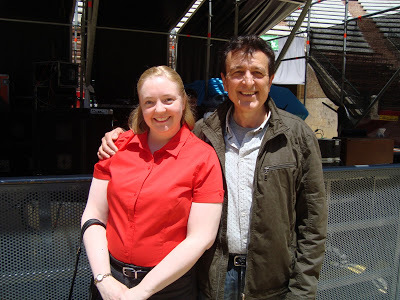 Famous author + famous recording artist = one great afternoon I posted that photo on Facebook even though almost none of my friends would know what was going on and got loads of likes. And then I posted it in the Manolo García group, and got just as many likes and one person who was envious: “I was in Valencia and I didn't get the chance to do that!” That’s the funny thing. I only had this opportunity because something terrible happened to me years before, and I had a great husband who insisted I write to tell Manolo all about it. And again years later to tell him we would be in Valencia. It was a case of asking and receiving. And having a compelling story.
Famous author + famous recording artist = one great afternoon I posted that photo on Facebook even though almost none of my friends would know what was going on and got loads of likes. And then I posted it in the Manolo García group, and got just as many likes and one person who was envious: “I was in Valencia and I didn't get the chance to do that!” That’s the funny thing. I only had this opportunity because something terrible happened to me years before, and I had a great husband who insisted I write to tell Manolo all about it. And again years later to tell him we would be in Valencia. It was a case of asking and receiving. And having a compelling story. Manolo put his glasses back on while I insisted on taking the camera to get the guys together, and they were chatting away. I took a picture before they were ready, and that turned out to the best one. They’re standing together absorbed in the moment. So beautiful!
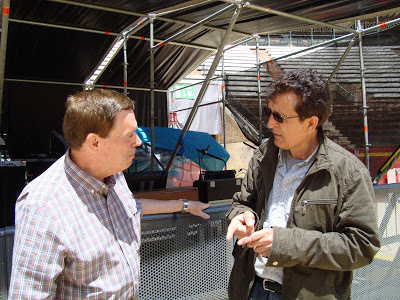 Two pals in Valencia At that point it had been maybe ten minutes, and who would dare to ask for more than that? I thought it was about over, but it wasn’t! We walked close to the stage to get out of the sun and kept chatting. He was talking about how his songs are “pocket philosophy” and the kinds of messages in them (so many, so wonderful, IMHO). He knew I could understand, “But what I don’t understand is how can someone who doesn’t know Spanish…” I always knew that would be the real kicker, that Manolo García would want to meet my rara avis husband who listened to his songs on repeat without knowing anything they say.
Two pals in Valencia At that point it had been maybe ten minutes, and who would dare to ask for more than that? I thought it was about over, but it wasn’t! We walked close to the stage to get out of the sun and kept chatting. He was talking about how his songs are “pocket philosophy” and the kinds of messages in them (so many, so wonderful, IMHO). He knew I could understand, “But what I don’t understand is how can someone who doesn’t know Spanish…” I always knew that would be the real kicker, that Manolo García would want to meet my rara avis husband who listened to his songs on repeat without knowing anything they say. 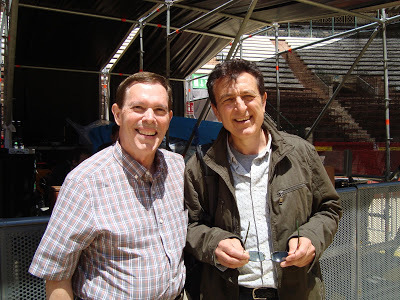 That sun is bright! Stanley said something elegant about how he can hear the emotional impact in spite of the language barrier, and that the music is beautiful, and, “You’re a good singer.”
That sun is bright! Stanley said something elegant about how he can hear the emotional impact in spite of the language barrier, and that the music is beautiful, and, “You’re a good singer.” “Oh, thank you,” said the man with the magic voice. (And so well preserved, too! Like a fine wine, they say all over Spain.) I may have been reading into his quick-moving eyebrows, but he seemed surprised or taken aback. I'm sure it's such an assumed, obvious thing that no one had told him he's a good singer for some time. Leave it to my earnest husband to fill in a gap.
We mentioned the CD with all the songs in the car, and in Spanish I said, “Sometimes he asks me, ‘What does this song mean?’ and I translate.” Or I tried, anyway.
Other topics included where we were born, how he feels LA is fake, the time when they asked him to stay in New York and work on his English to cross over, but he said no, he’s happy in Spanish, Native American cultures he admires, living with Nez Perce in Idaho (What! When was that?), and lapsing into Spanish at one point because he was so into telling us how he felt about protecting the environment by adopting natural practices. I looked at Stanley and said, “Are you getting this?” and interpreted a little, but we quickly moved on to politics. Everyone present was in agreement.
He’s a voracious reader (About a month after this encounter, he publicly said, "Happiness is being a voracious reader and raising chickens."), and he recommended Lucia Berlin's stories to me. (I asked for the collection A Manual for Cleaning Women at my local bookstore as soon as we got back, because when Manolo García recommends a book to you, you don’t not read it. It's as awesome as he said.) He was speaking Spanish again, about the importance of music and the other arts because of the world we live in, and I felt so accomplished that I managed to blurt, “Soy escritora también” (I'm a writer, too).
“Oh, What do you write? Novels, plays…”
“Novels,” I clarified, nodding my head so much it’s amazing it didn’t fly off. “My first came out two days ago” (I was being literal, remembering Awash in Talent 's preorder status on May 24) “and the second comes out in December and is based on the legend of the seven noble knights of Lara.”
A pause, as if he was never expecting to have to take in so much information. And then, “Es muy importante ese tipo de creatividad.” (That kind of creativity is really important.) He said more on that theme, but I was too blown away to remember. Manolo García said my writing is important. I have a responsibility not to let him down now.
I think things were slowing down, and Stanley and I were just staring at him, smiling, and could have done that until the end of time. “No quiero cansaros…” (I don't want to wear you out), he said.
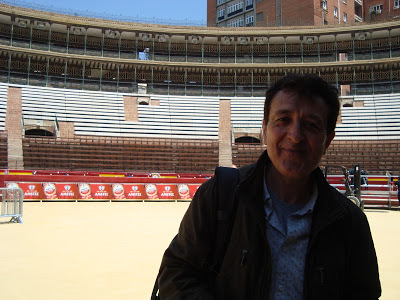 Photo by Jessica Knauss “¡Por favor!” (Puh-lease!), I interjected, snapping another photo of him in the shade. Sometime during these lovely moments, fans gathered outside the side gate of the bullring. They could see their idol talking to two lousy Americans, and they shouted “¡Manolo!” and did the flamenco clapping rhythm from his most popular song, “Pájaros de barro.” I kept looking over at them, but he must get this all the time. He started apologizing that we couldn’t have that cup of coffee he'd promised me so long ago on a watercolor painting. When were we leaving Spain?
Photo by Jessica Knauss “¡Por favor!” (Puh-lease!), I interjected, snapping another photo of him in the shade. Sometime during these lovely moments, fans gathered outside the side gate of the bullring. They could see their idol talking to two lousy Americans, and they shouted “¡Manolo!” and did the flamenco clapping rhythm from his most popular song, “Pájaros de barro.” I kept looking over at them, but he must get this all the time. He started apologizing that we couldn’t have that cup of coffee he'd promised me so long ago on a watercolor painting. When were we leaving Spain? “El lunes” (Monday), I said, dreading that horrendous eventuality.
“In two days, I’m giving a concert in Sevilla. Can you come?”
Utter astonishment. “No tenemos entradas.” (We don't have tickets.)
“Doesn’t matter. I invite you.”
What! Is this really the kind of thing that happens in Manolo’s reality?
Yes. Yes, it is.
“Right now,” he said, “I don’t have time, because I have interviews and things, but in Sevilla, I have nothing, so we can get together, chat, have wine, or coffee…”
“Cola cao…” I said, amazed I could form any words with so much dopamine sloshing around in my head. I said “Cola cao” to Manolo García! It's the iconic Spanish chocolate drink, and it shows up in one of his songs from 1993.
“Cola cao,” he approved. You can’t ask for rewards like that.
Yes, yes, all nodding and happy smiles. Stanley and I didn’t commit to going to Sevilla, but we reveled in the invitation.
And here came Marta. Manolo must've needed to be somewhere, but she smiled and waved at us as if we weren’t disrupting their whole schedule. She was speaking Spanish, and Manolo was still speaking English for Stanley’s benefit, and he told her to let us come in before the doors opened to the public at 7:30 that night so we can choose our seats tranquilamente, and that he’s invited us to Sevilla to be sure she can arrange it and I can’t remember much else because it was all welling to a climax. I recall him charmingly saying, “I wait for you…” and trailing off because he couldn’t figure out the verb construction. I know he meant, "I hope to see you in Sevilla." Lovely Spanish has no distinction between waiting and hoping. I was hopingfor the two kisses on the cheek goodbye, but no, he shook our hands again in the American style.
“Voy a saludar a esta gente” (I'm going to say hi to these people). He was referring to the clapping fans outside the gate.
No, don’t leave. Don’t let this moment end. I felt ashamed of this selfish thought immediately. It had been the best half hour Stanley and I had experienced, and believe me, we knew about wonderful moments. It passed in the blink of an eye, as all the best moments do, and memory and gratitude remain.
As soon as Manolo was a significant distance away, accompanied closely by Marta, Stanley looked at me and said, “He’s nice.” Always the understated one, my true love.
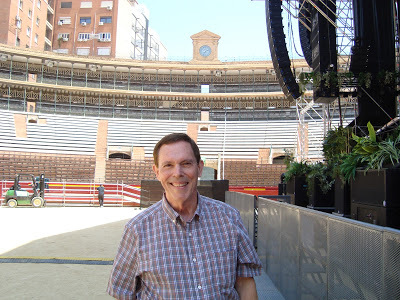
I grabbed Stanley and hung on, incredulous. “Oh my God, so nice!” Words. They failed me. “Thank you!” I said. It was because of Stanley's insistence that any of this happened. I would never have written to my idol at all, much less twice, eight years apart.
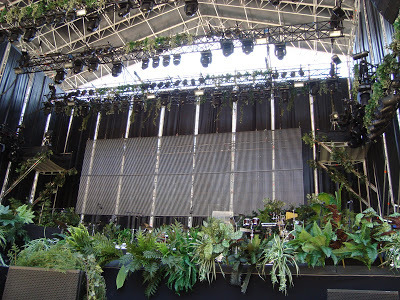
I took a picture of Stanley in the empty bullring and of the plants on the stage, then as we made our way out, I snapped a blurry one of Marta and Manolo standing at the bullring door, clasping hands with those fans through the bars. (How does he not pick up every disease known to humankind?)
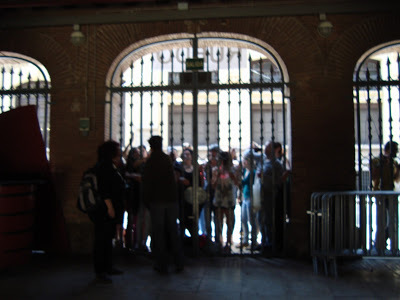
Manolo's face is so expressively dynamic, I think Stanley would have understood the gist no matter what language he was speaking. Watching the undulating muscles and the slope of certain angles, the only word I could think of was "creativity." Unbridled creativity. He seemed so much taller than I’d expected. Looking at the pictures, in which he seems normally proportioned, I'm guessing that was one more effect of his charisma.
Stanley thought his English was perfect, and separately pointed out his humanity by saying that his temples showed greys and he needed another dye job. I think Manolo put the glamour on both of us: he struggled with English (delightfully, and I was thrilled to come to his linguistic aid) and Stanley couldn’t perceive it, while I thought his hair showed no signs of age. After we got home, Stanley made a point of showing me in videos that Manolo has a little bald spot in the back. “He’s human,” my darling husband said. Yes, he’s human, that’s the incredible thing. More than once I’ve come to the conclusion that a world with such a human in it cannot be a terrible place.
From there, barely able to navigate the metro under the love-drunk influence of having my whole artistic life converge in one place, I started to feel we should be hounded by the press so everyone could find out what’s so special about us that we got such a magnificent gift. We retrieved the car and drove to the laundry. They were closed for siesta. I wondered if we would ever get our clothes.
We returned to the hotel room to rest—as if!—in preparation for staying up late that night. I collapsed across the bed and Stanley was at the computer looking up how far it was to Sevilla and then Sevilla to Madrid, and hotels in Sevilla, and did I want to do it or not? I felt bad making Stanley drive so much because although I had no clue how much he must've been suffering, he seemed tired. And we would lose what we’d already paid for the next few days for our Valencia hotel, and the Sevilla hotel would be another expense, added to the all those phone calls with Marta! And there was the matter of not having seen much of Valencia and the whole reason we chose Valencia was so we could see Valencia, and it does seem worth a good visit.
But that all pales in comparison to an invitation from Manolo García. Even while I was feeling, and Stanley agreed, that the half hour was better than anything anyone could ever have imagined, much less asked for, lying there, I made a conscious choice to abandon plans and live for the art of living.
In the next posts: I'd been waiting more than twenty years to go to a Manolo García concert. Now I'm going to not one, but two?
Catch up with the rest of the posts in this series here.
Published on June 05, 2017 00:30
June 2, 2017
Morella and Peñíscola: The Trip of a Lifetime, Part 8
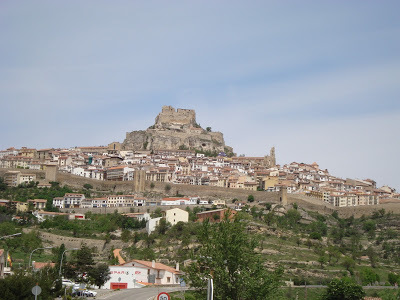 Morella
MorellaPhoto by Jessica Knauss This May 2016 trip was the first time I'd been south of Barcelona on the Mediterranean coast. I can now report that it has more marvels than can be counted; Stanley and I experienced two of them in detail.
MorellaWe glided down the coast in the sunshine, then hung a right into the interior. We passed unique villages at every turn, Valencia orange groves, and terrace farms, until we twisted upon the sight of Morella with its castle grandly perched above a medieval town perfectly belted in by a medieval wall.
Morella came about because Stanley loved Frías so much in 2015. Frías is a pueblo más bonito in the province of Burgos. It was so beautiful our eyes metaphorically exploded, and Stanley couldn't stop talking about it for months afterward. "Let's live there! Let's remodel the castle and that can be our house."
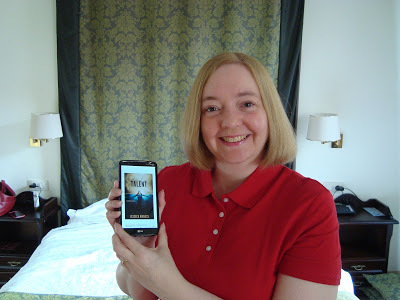 Living like a queen published novelist in Morella Between telling him the plumbing project would be extraordinarily difficult and that I was willing, anway, I planned our 2016 trip and saw that I might be able to outshine Frías with Morella because Morella has a fifteenth-century palace you can stay at! We were livin' large there in a room that looked grandiose but was still comfortable. According to TripAdvisor, it has the best showers in Spain! This royal treatment felt especially appropriate the following morning, when I awoke to
Awash in Talent
being ready for preorder. Yes, this 2016 was turning out to be my year. I was staying in a medieval palace with my true love by my side, and I was a published novelist.
Living like a queen published novelist in Morella Between telling him the plumbing project would be extraordinarily difficult and that I was willing, anway, I planned our 2016 trip and saw that I might be able to outshine Frías with Morella because Morella has a fifteenth-century palace you can stay at! We were livin' large there in a room that looked grandiose but was still comfortable. According to TripAdvisor, it has the best showers in Spain! This royal treatment felt especially appropriate the following morning, when I awoke to
Awash in Talent
being ready for preorder. Yes, this 2016 was turning out to be my year. I was staying in a medieval palace with my true love by my side, and I was a published novelist.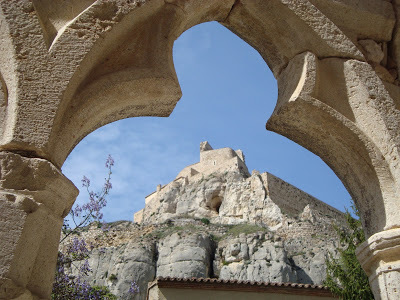 Photo by Jessica Knauss The castle at Morella was originally carved straight out of the rock by ancient peoples, and has been in continuous use for millennia. It participated in every major conflict that passed through the Iberian Peninsula, including the Napoleonic Wars. It's more than 1000 meters high, and Stanley and I took the winding path through town and all the way up. If you read the sad portion of the last post and saw Stanley's diagnosis, you'll know how extraordinary it was that he could keep up with me without showing the slightest sign of distress.
Photo by Jessica Knauss The castle at Morella was originally carved straight out of the rock by ancient peoples, and has been in continuous use for millennia. It participated in every major conflict that passed through the Iberian Peninsula, including the Napoleonic Wars. It's more than 1000 meters high, and Stanley and I took the winding path through town and all the way up. If you read the sad portion of the last post and saw Stanley's diagnosis, you'll know how extraordinary it was that he could keep up with me without showing the slightest sign of distress.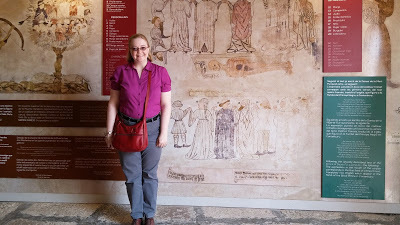 Here I am with the diagrams that explain the dance of death.
Here I am with the diagrams that explain the dance of death. It's a round dance, a popular form in the Middle Ages. You get to the castle via a ruined Franciscan monastery, which has an extraordinary example of medieval wall painting that depicts the dance of death. This was a popular theme for all the arts in medieval Catalunya. It shows how everyone, from the pope to the poorest indigent, is equal in the eyes of Death. It's a great opportunity to look at how medieval society saw itself.
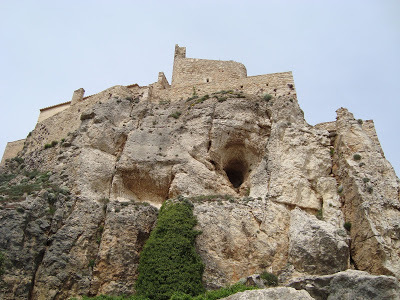
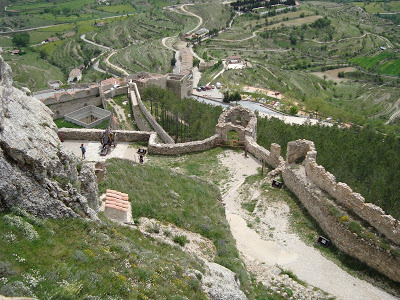 As you ascend the castle, you pass through history. You name it, it happened here. We saw barracks, parade grounds, the prison where they held a king, and views for days. It all culminates at the top, where they have the Plaza de Armas and the governor's quarters, which bring the trip full circle because they're inside a neolithic cave. There's plenty of material here for a novel series.
As you ascend the castle, you pass through history. You name it, it happened here. We saw barracks, parade grounds, the prison where they held a king, and views for days. It all culminates at the top, where they have the Plaza de Armas and the governor's quarters, which bring the trip full circle because they're inside a neolithic cave. There's plenty of material here for a novel series.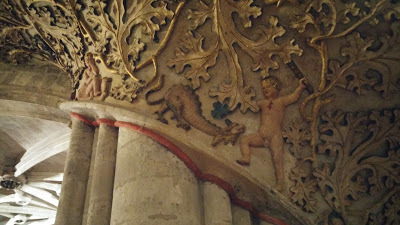 Slaying the dragon on the choir staircase, Basílica de Santa María Morella also has medieval churches with neverending wonders, whether the world-class organ, the staircase into which the artist sculpted a signature, or the treasury—up several back stairs so you have a long way to go if you're trying to steal something.
Slaying the dragon on the choir staircase, Basílica de Santa María Morella also has medieval churches with neverending wonders, whether the world-class organ, the staircase into which the artist sculpted a signature, or the treasury—up several back stairs so you have a long way to go if you're trying to steal something.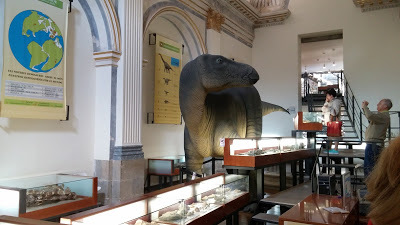 Life-sized model of Morelladon beltrani in a former convent where you can
Life-sized model of Morelladon beltrani in a former convent where you can still see traces of the Baroque paint job What's cooler than cool? A place that has its own dinosaur! Yep, Morelladon beltrani takes the first part of its mellifluous name from Morella. The dinosaur museum is housed in a former convent, so you get a sense of human history and truly ancient prehistory in one place. What a fantastic way to recycle.
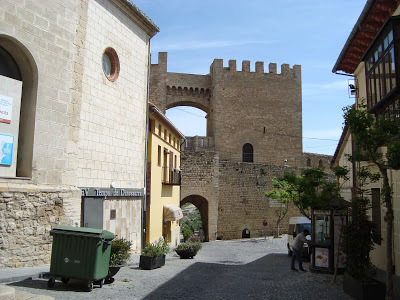 One of the city gates; convent/dinosaur museum on the left We ate really well right on the street with our hotel and were able to sample Morella's signature pastry, too. Called flaó, it's folded into an empanada shape and filled with ricotta cheese, almonds, and cinnamon. It's so deliciously subtle, you could chomp through a whole shelf's worth without blinking.
One of the city gates; convent/dinosaur museum on the left We ate really well right on the street with our hotel and were able to sample Morella's signature pastry, too. Called flaó, it's folded into an empanada shape and filled with ricotta cheese, almonds, and cinnamon. It's so deliciously subtle, you could chomp through a whole shelf's worth without blinking.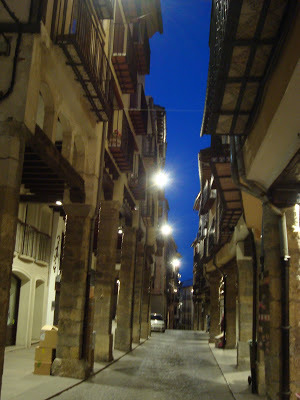 The street with our hotel by night. Bona nit! Please do not go to Morella. It's one of the pueblos más bonitos de España, it has plenty of attractions and more shops and restaurants than I would've thought would fit comfortably in such a small space, and you can get anywhere on foot. But the best thing about it was that it felt like it was ours. We saw few tourists, and they all seemed to leave at about 7 p.m., leaving us to have dinner with locals and wander the streets with people saying "Bona nit!" to us as if we belonged there. I realized they were saying "Good evening" in Valencian, but the linguistic thrill was too distracting for me to say the same thing back, so mostly I waved and smiled. The coziness was such a relief after the crowds at Park Güell! So please, do not add to the numbers. Do not go to Morella.
The street with our hotel by night. Bona nit! Please do not go to Morella. It's one of the pueblos más bonitos de España, it has plenty of attractions and more shops and restaurants than I would've thought would fit comfortably in such a small space, and you can get anywhere on foot. But the best thing about it was that it felt like it was ours. We saw few tourists, and they all seemed to leave at about 7 p.m., leaving us to have dinner with locals and wander the streets with people saying "Bona nit!" to us as if we belonged there. I realized they were saying "Good evening" in Valencian, but the linguistic thrill was too distracting for me to say the same thing back, so mostly I waved and smiled. The coziness was such a relief after the crowds at Park Güell! So please, do not add to the numbers. Do not go to Morella.We had a difficult time leaving this enchanted space. But more wonders awaited us, so we pressed on.
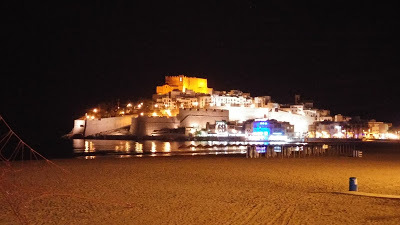 Peñíscola
PeñíscolaPhoto by Stanley Coombs
PeñíscolaPeñíscola (pain-YEES-ko-la) has two claims to fame: the beach and the castle. The castle also has two big claims to fame: Papa Luna and some scenes from Game of Thrones.
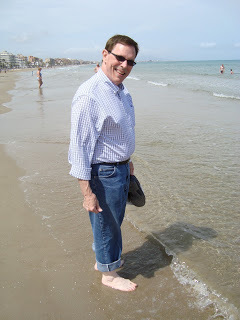 The beach isn't really our scene, so after we dipped our toes in the Mediterranean, we headed over to the castle. It's the kind of thing you don't need a map for.
The beach isn't really our scene, so after we dipped our toes in the Mediterranean, we headed over to the castle. It's the kind of thing you don't need a map for.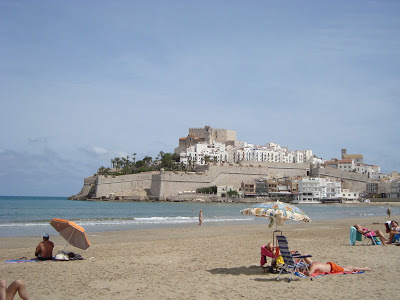 Photo by Jessica KnaussThe solid, imposing, and delicately placed castle at Peñíscola was founded in the thirteenth century by the knights templar. When you visit, most of the practical fortress qualities come from this time. Its most famous resident, however, was Pedro Martínez de Luna, or Benedict XIII, Papa Luna, Spain's antipope. If you like antiheroes, as I think I must, you'll find his stubborn personality attractive.
Photo by Jessica KnaussThe solid, imposing, and delicately placed castle at Peñíscola was founded in the thirteenth century by the knights templar. When you visit, most of the practical fortress qualities come from this time. Its most famous resident, however, was Pedro Martínez de Luna, or Benedict XIII, Papa Luna, Spain's antipope. If you like antiheroes, as I think I must, you'll find his stubborn personality attractive.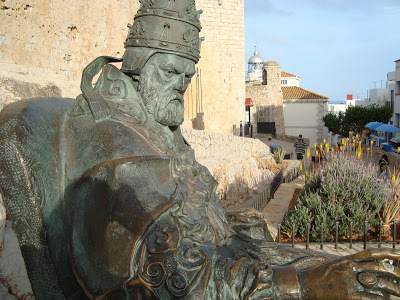 The stern statue of Don Pedro in his papal garb greets castle visitors and passersby.
The stern statue of Don Pedro in his papal garb greets castle visitors and passersby.Photo by Jessica Knauss Papa Luna was a cardinal at the time of the Western Schism and tended to the flock throughout Spain and parts of France for the Avignon popes, or antipopes, as they're known. He was elected Avignon pope in 1398. His branch of the papacy was in decline, with most of the Christian nations refusing to recognize his legitimacy as they tended toward reunification with the Roman pope. He was offered a few different deals to resign and bring the Western Schism to an end. When he refused them, he was excommunicated... but he was his own pope, so I doubt he took that seriously. At that time, in 1417, he came to live at Peñíscola and there, he held onto his holy title with both hands until his death in 1423.
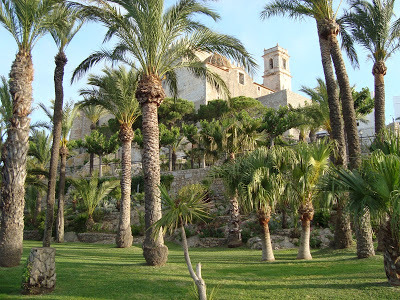 Photo by Jessica Knauss I had to admire his dedication to study: several large rooms in the castle were marked "library" or "study" and even his personal rooms (he had more than one place for sleeping to stave off assassination attempts) had lovely fifteenth-century bookcases open to the sea air. Is there something about scholars that makes them extraordinarily tenacious? Because I also admire his persistence and recognized it in myself.
Photo by Jessica Knauss I had to admire his dedication to study: several large rooms in the castle were marked "library" or "study" and even his personal rooms (he had more than one place for sleeping to stave off assassination attempts) had lovely fifteenth-century bookcases open to the sea air. Is there something about scholars that makes them extraordinarily tenacious? Because I also admire his persistence and recognized it in myself.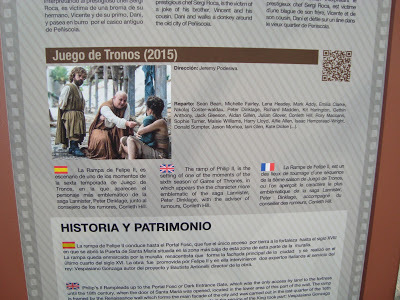
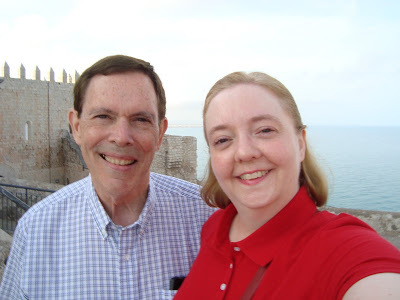 Stanley was persistent, too, for the things that really mattered to him. We still had no news from our idol, Manolo García. You can bet he had me check every chance we got. Tick tock!
Stanley was persistent, too, for the things that really mattered to him. We still had no news from our idol, Manolo García. You can bet he had me check every chance we got. Tick tock!Catch up with the rest of the posts in this series here.
Published on June 02, 2017 00:30
May 31, 2017
Three Days in BCN: The Trip of a Lifetime, Part 7
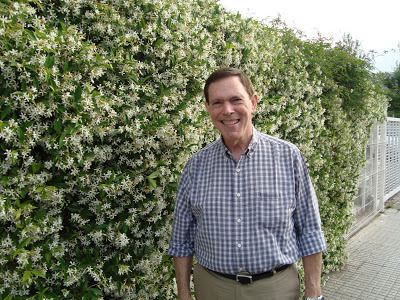 Stanley's sweet smile with the honeysuckle near our hotel Barcelona is one of the most visited cities in the world, and with good reason. There's so much to see and do that's unique. The richness and the hugeness overwhelmed me and Stanley, probably because I hadn't prepared as thoroughly as I should have. I had been to Barcelona already—eighteen years before!—so that meant I knew my way around. Ha ha.
Stanley's sweet smile with the honeysuckle near our hotel Barcelona is one of the most visited cities in the world, and with good reason. There's so much to see and do that's unique. The richness and the hugeness overwhelmed me and Stanley, probably because I hadn't prepared as thoroughly as I should have. I had been to Barcelona already—eighteen years before!—so that meant I knew my way around. Ha ha. In spite of my bungling, we enjoyed ourselves at four enchanted places I've never been to before. We started with Montjuïc, mainly because we'd read The Shadow of the Wind together and it sounded fascinating.
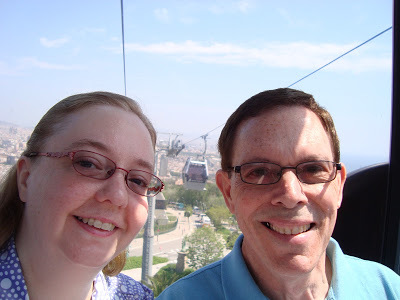 Montjuïc is one of many peaks in the city and the name tells me it was the Jewish Quarter in the Middle Ages. Now, among other things, it has a castle and an enormous park with paths and little restaurants, and because you can get there by funicular, that's what we did.
Montjuïc is one of many peaks in the city and the name tells me it was the Jewish Quarter in the Middle Ages. Now, among other things, it has a castle and an enormous park with paths and little restaurants, and because you can get there by funicular, that's what we did. 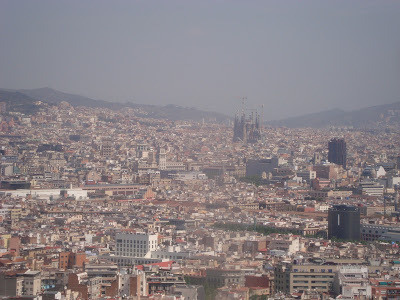 You could see the Sagrada Família from just about anywhere, it seemed. The city looked more vast the higher up we got. A couple of ladies from Scotland were in the car with us, and one of them insisted she would never look at the views. I sympathized that it's ridiculous to voluntarily dangle oneself hundreds of feet in the air in a rocking capsule that feels as if it will snap free of its moorings with the next breeze, but I was with my true love! What else mattered? I wasn't going to miss those views!
You could see the Sagrada Família from just about anywhere, it seemed. The city looked more vast the higher up we got. A couple of ladies from Scotland were in the car with us, and one of them insisted she would never look at the views. I sympathized that it's ridiculous to voluntarily dangle oneself hundreds of feet in the air in a rocking capsule that feels as if it will snap free of its moorings with the next breeze, but I was with my true love! What else mattered? I wasn't going to miss those views! 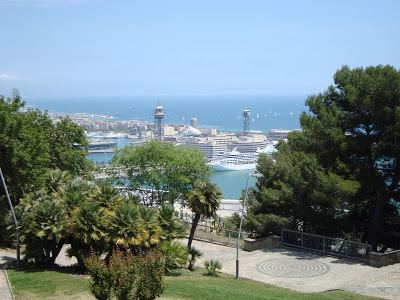 It was a gorgeous day.
It was a gorgeous day.
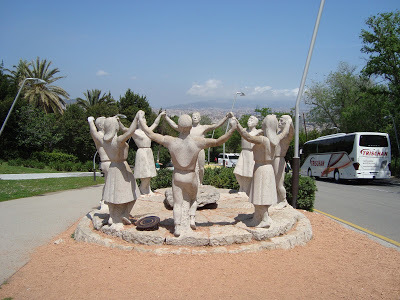 The monument to the sardana, the Catalan dance par excellence We took the funicular all the way to the castle at the top of Montjuïc. I thought that from there, we could easily access the other attractions. We found out the exhausting way that yes, you can reach the other attractions, but "easily" is not in the cards for someone who hasn't done her research. In my memory, we spent about forty hours wandering, hot, sweaty, and thirsty, before we found someone who gave us a map of the mount and instructions for taking a bus where we wanted to go.
The monument to the sardana, the Catalan dance par excellence We took the funicular all the way to the castle at the top of Montjuïc. I thought that from there, we could easily access the other attractions. We found out the exhausting way that yes, you can reach the other attractions, but "easily" is not in the cards for someone who hasn't done her research. In my memory, we spent about forty hours wandering, hot, sweaty, and thirsty, before we found someone who gave us a map of the mount and instructions for taking a bus where we wanted to go. 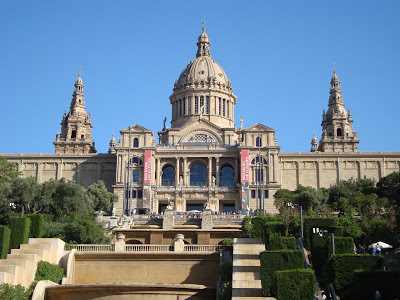 The building of my childhood desire
The building of my childhood desirePhoto by Jessica Knauss The epic journey made finding the National Museum of Catalan Art all the more meaningful. I had a poster in my childhood bedroom with a photo of this building that mysteriously read, "SPAIN." Where? What? Why? I wondered and wondered (this was before the internet) for ten years or more. And now I was going inside that building, only to find that it contains some of the most wonderful things ever produced in the world of art.
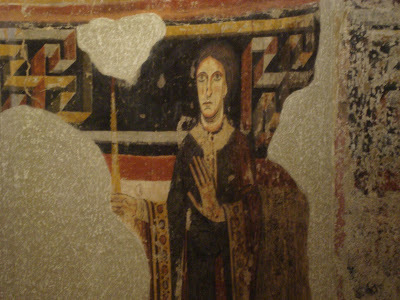 Countess Llúcia of Pallar, the noble lady who donated the money for this altarpiece,
Countess Llúcia of Pallar, the noble lady who donated the money for this altarpiece, has been immortalized in the painting. She looks like a Seven Noble Knights character for sure. It has a modern section, sure. But most of the collection is medieval. (Can you see the fairy dust around that word?) During the age of the American philanthropist (early twentieth century), Catalan art conservators made it their mission to save unique art that was at severe risk both of crumbling under the elements and of being carted off by rich American collectors. The result is the biggest, and dare I say, the richest collection of Romanesque art in the world.
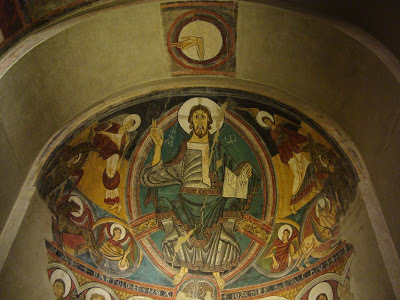 They preserved entire apses of churches. This is part of the masterpiece,
They preserved entire apses of churches. This is part of the masterpiece, Sant Clement de Taüll, c. 1123. I love Romanesque art. The style was produced all over Europe in the eleventh and twelfth centuries. When the Gothic style swept through, you can bet there were a lot of Romanesque casualties. It would be like a contractor today demolishing a 1960s concrete brutalist structure to make way for whatever the latest steel-and-glass high-rise style is today. You can hardly find this stuff anywhere. If I happened to find a Romanesque piece in a museum—and you can be sure it would be a single piece—I would always linger with it the longest for its rarity and its elegant execution.
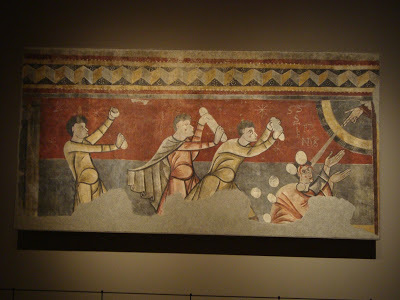 The Lapidation of St. Stephen from Sant Joan de Boí
The Lapidation of St. Stephen from Sant Joan de BoíStanley's question: "Why are they throwing bread loaves?" So my head exploded. I'd had no idea that was what was in the National Museum of Catalan Art—otherwise, you can bet I would've returned to Barcelona much sooner. How could I take all this home with me? Only in pictures. These give the barest hint of the wonder of being there. My sweet husband followed me around for hours (seemed like a few minutes to me), dazed and amused and taking photos of anything I asked him to and often without need for a request. I asked him if he was enjoying himself, if there was something he'd rather do, if he never wanted to see another medieval picture or sculpture again, and he assured me he was fine with all of it, as long as it made me happy. The whole trip is a monument to his easygoing happiness.
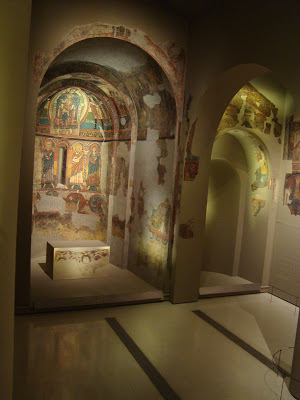 A whole chapel! There was so much left to see in the museum that we ditched our downtown plans for the next day and returned. This time I merely visited my pal, the Romanesque wing, and wandered in the smaller but just as lovely Gothic section and through the twentieth century floor.
A whole chapel! There was so much left to see in the museum that we ditched our downtown plans for the next day and returned. This time I merely visited my pal, the Romanesque wing, and wandered in the smaller but just as lovely Gothic section and through the twentieth century floor.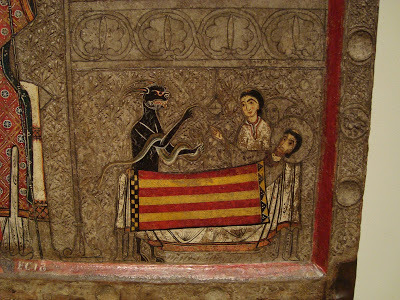 Close up of an altar frontal from Sant Martí de Gia,
Close up of an altar frontal from Sant Martí de Gia, in which St. Martin repudiates the devil on his deathbed.
Thirteenth century. The artist signed his work!
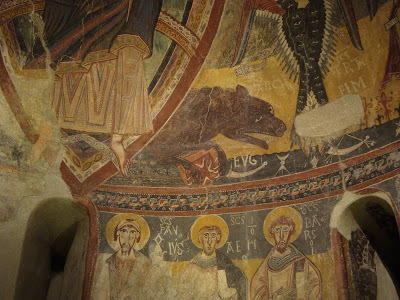 Saints and beasts and seraphim, oh my! Twelfth century. I'm still not sure why I, with my training in medieval studies, was not aware of the National Museum of Catalan Art with all its medieval Catalan glory. I am now, and that's what matters.
Saints and beasts and seraphim, oh my! Twelfth century. I'm still not sure why I, with my training in medieval studies, was not aware of the National Museum of Catalan Art with all its medieval Catalan glory. I am now, and that's what matters.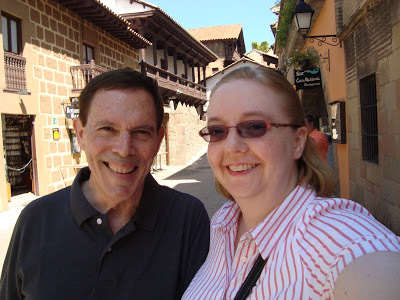 Stanley and I in Cantabria? No, it's the Poble Espanyol!
Stanley and I in Cantabria? No, it's the Poble Espanyol!
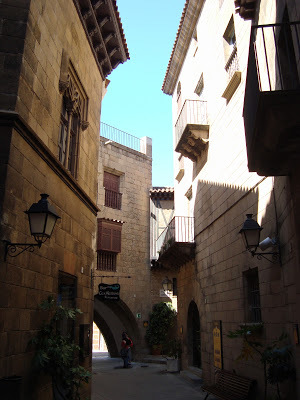 It was all so lovely, I didn't know where to look. We spent the rest of that day at an attraction on Montjuïc that felt like the contents of my head brought into reality. The Poble Espanyol (Spanish Village) was constructed as a world's fair type of exhibition. I knew this, and I expected it to be kind of cardboard and superficial. But no, it's nothing if not thorough. These are architecturally exact replicas of specific buildings from all the distinct regions of Spain. Later, in Morella, we actually recognized a building whose replica we'd seen here!
It was all so lovely, I didn't know where to look. We spent the rest of that day at an attraction on Montjuïc that felt like the contents of my head brought into reality. The Poble Espanyol (Spanish Village) was constructed as a world's fair type of exhibition. I knew this, and I expected it to be kind of cardboard and superficial. But no, it's nothing if not thorough. These are architecturally exact replicas of specific buildings from all the distinct regions of Spain. Later, in Morella, we actually recognized a building whose replica we'd seen here!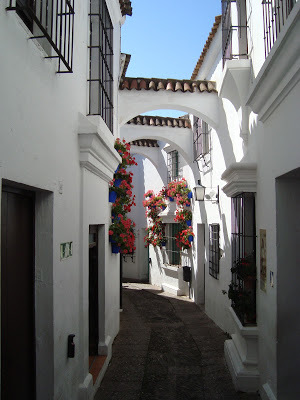 Andalucía, right? Nope. El Poble Espanyol. We ate, wandered, saw art, had ice cream. The concentration of so many of the beauties of the Iberian Peninsula in one space amazed me. You could practically take Spain with you in your pocket. Why would you need to visit the rest of the peninsula when it's all right here? Yes, it's a tourist trap, but if I were ever condemned to live in a tourist trap, I would choose the Poble Espanyol. We rested in the shade of an Andalusian plaza and I was filled with nostalgia. We weren't planning to head to Andalucía on this trip. "Are we really in Barcelona?" I had to ask.
Andalucía, right? Nope. El Poble Espanyol. We ate, wandered, saw art, had ice cream. The concentration of so many of the beauties of the Iberian Peninsula in one space amazed me. You could practically take Spain with you in your pocket. Why would you need to visit the rest of the peninsula when it's all right here? Yes, it's a tourist trap, but if I were ever condemned to live in a tourist trap, I would choose the Poble Espanyol. We rested in the shade of an Andalusian plaza and I was filled with nostalgia. We weren't planning to head to Andalucía on this trip. "Are we really in Barcelona?" I had to ask.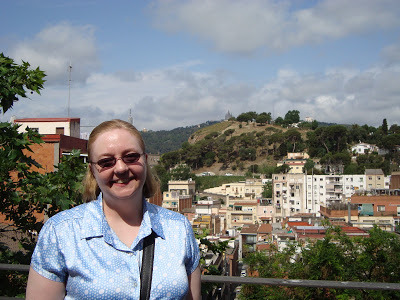 Mt. Tibidabo (also mentioned a lot in
The Shadow of the Wind
) in the far back,
Mt. Tibidabo (also mentioned a lot in
The Shadow of the Wind
) in the far back, on the scenic route to Park Güell. When we got back to the hotel that night, we came to a reluctant realization that the next day was our last in Barcelona. Time to pull away from Montjuïc and do something else I'd never done before: visit Park Güell. For this, I was half prepared. I'd poked around online, looking for an easy way to get there without too much walking or a high taxi fare. I found step-by-step instructions to more or less go in the back door. I carried the printout in front of me for the entire journey, which involved secret metro stops and hidden escalators. It was so cloak-and-dagger, we thought we might get led into some kind of traveler's trap, but it ended up being 100 percent reliable.
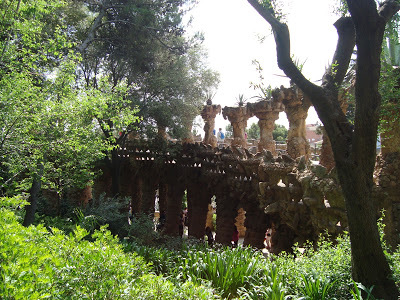 Park Güell was designed by the famous Antoni Gaudí as a gated residential community for Barcelona's upper crust. The development failed and only a few buildings came into being, but I think most people agree it's better this way. Through the back door, there were just a few people, a normal day at a city park, and we enjoyed the unique design elements, the plants, and the buskers.
Park Güell was designed by the famous Antoni Gaudí as a gated residential community for Barcelona's upper crust. The development failed and only a few buildings came into being, but I think most people agree it's better this way. Through the back door, there were just a few people, a normal day at a city park, and we enjoyed the unique design elements, the plants, and the buskers.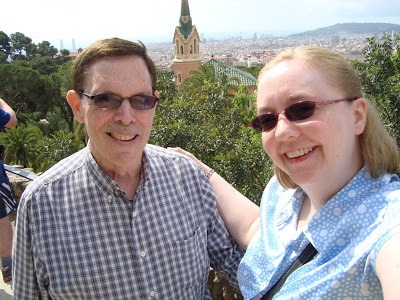 As we progressed downhill, so did the experience. The crowds started to swarm, and the big blow came when we learned you have to pay eight Euros to hang around in the Monumental Zone. I'd seen references to the Monumental Zone in the brief research I'd done. I hadn't realized it referred the the famous spot with all the tilework—where everyone wants to be, to put it bluntly.
As we progressed downhill, so did the experience. The crowds started to swarm, and the big blow came when we learned you have to pay eight Euros to hang around in the Monumental Zone. I'd seen references to the Monumental Zone in the brief research I'd done. I hadn't realized it referred the the famous spot with all the tilework—where everyone wants to be, to put it bluntly.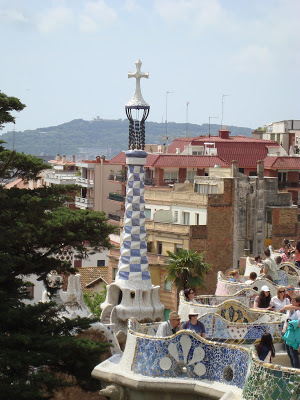 The part everyone thinks of. Stanley took great offense at the high price and the long lines and we decided it wasn't worthwhile. We'd been happier above, when it was just a city park.
The part everyone thinks of. Stanley took great offense at the high price and the long lines and we decided it wasn't worthwhile. We'd been happier above, when it was just a city park.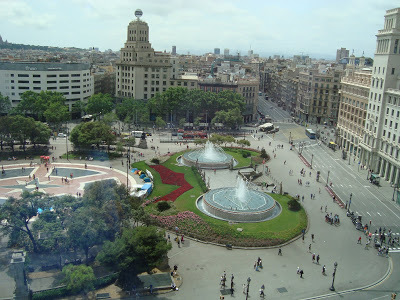 Plaça Catalunya from the Corte Inglés After a few moments of frustration, we got on a city bus that took us past amazing sights like Casa Milà and Casa Batllò, but nevertheless seemed as if it would never end. It ended up in the Plaça Catalunya, and I got to show Stanley a little bit of the Rambla. The first time I stayed in Barcelona, my hotel was just off the Rambla, in the middle of everything.
Plaça Catalunya from the Corte Inglés After a few moments of frustration, we got on a city bus that took us past amazing sights like Casa Milà and Casa Batllò, but nevertheless seemed as if it would never end. It ended up in the Plaça Catalunya, and I got to show Stanley a little bit of the Rambla. The first time I stayed in Barcelona, my hotel was just off the Rambla, in the middle of everything.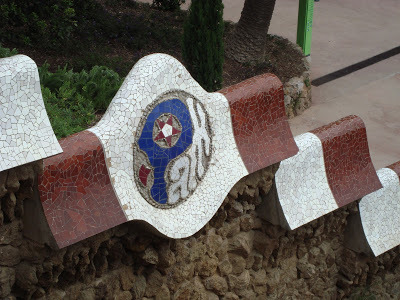
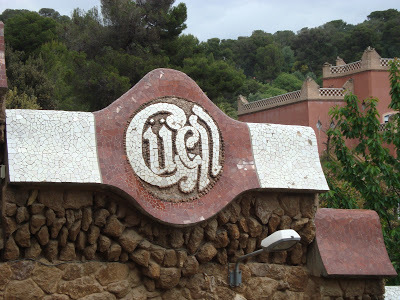 I still admire Antoni Gaudí and his park, but there was nothing in the world that I hated more than seeing Stanley disappointed—he never asked for very much!—so the day ended with a sense of defeat. I resolved to never plan a big city sojourn so poorly again. I would get a real idea of crowds and fees and avoid them like the plague. I would make note of all the inexpensive places to eat food Stanley liked so as to never be stranded. I would hire a chariot to drive us from place to place with no worries.
I still admire Antoni Gaudí and his park, but there was nothing in the world that I hated more than seeing Stanley disappointed—he never asked for very much!—so the day ended with a sense of defeat. I resolved to never plan a big city sojourn so poorly again. I would get a real idea of crowds and fees and avoid them like the plague. I would make note of all the inexpensive places to eat food Stanley liked so as to never be stranded. I would hire a chariot to drive us from place to place with no worries.Barcelona, I'm not done with you. Be ready, because next time I will be!
A sad piece of evidence I've run across while looking through these memories (skip if sad is not your thing): Our first night in Barcelona, Stanley requested we go to a pharmacy for more ibuprofen. It was only the fourth day of our journey, and I had packed more than enough pain reliever pills for two weeks for two healthy adults even if they were walking miles and miles a day—and he had already used up all those pills.
I was too busy interpreting for Stanley as he made his request at the parafarmacia (which could not sell us ibuprofen like a farmacia could, only aspirin) to comprehend how outlandish the situation was. When I say Stanley was not one to complain, that doesn't begin to describe it. Just over two months from the date of his quest for more pain relief, it was revealed that he had Stage IV lung cancer that had entirely blocked his right lung and metastasized to all his vertebrae, down to his tailbone.
The most he ever said, later, in June, was that his neck felt stiff.
That evening, the parafarmacista asked what he wanted the pills for. Did he have a headache?
"Something like that," he replied.
I want to say something profound here, but I think you can sense how haunting those words are to me already. End sad segment.
Had we had an email, a phone call, a text, a telegram from Manolo García? Not yet, not yet, became our litany of the evening. Even more than I, Stanley never gave up hope.
Catch up with the rest of the posts in this series here.
Published on May 31, 2017 00:30
May 29, 2017
The House That Love Built: The Trip of a Lifetime, Part 6
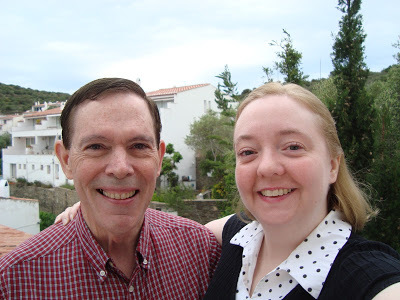 On the hotel balcony in Cadaqués. You can see it's early:
On the hotel balcony in Cadaqués. You can see it's early: Stanley's hair isn't even dry yet! When this post publishes, it will be ten months since the love of my life passed away.
On May 19, 2016, we had a schedule to maintain and got up early to marvel at Cadaqués in the daylight, in spite of thick cloud cover. Even eating the hotel breakfast was a feast for the eyes because the area had huge windows on all sides.
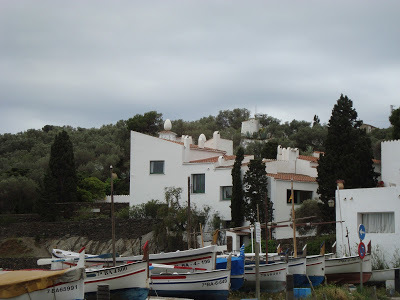 Cloudy day over the love mansion. Photo by Jessica KnaussIt was a short drive to Portlligat to the Dalí House-Museum, although we didn’t recognize it when we saw it. I’d always seen pictures of it in the sun; under the clouds, you had to look for the eggs on the roof. Although it’s a timed tour, with eight visitors at a time, the guide didn’t give a tour per se, but recited the rules in Spanish, French, and English and opened himself to questions. The other people on the tour, including an American and a French couple, were inquisitive and their curiosity made the experience personal.
Cloudy day over the love mansion. Photo by Jessica KnaussIt was a short drive to Portlligat to the Dalí House-Museum, although we didn’t recognize it when we saw it. I’d always seen pictures of it in the sun; under the clouds, you had to look for the eggs on the roof. Although it’s a timed tour, with eight visitors at a time, the guide didn’t give a tour per se, but recited the rules in Spanish, French, and English and opened himself to questions. The other people on the tour, including an American and a French couple, were inquisitive and their curiosity made the experience personal. 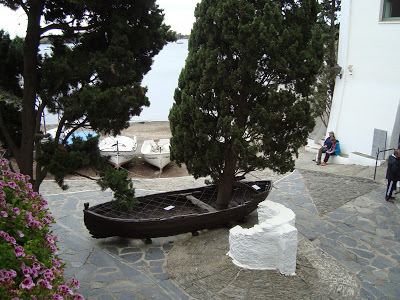 Photo by Jessica Knauss
Photo by Jessica Knauss
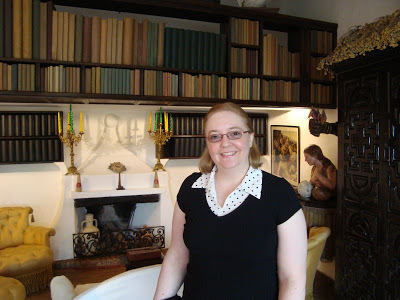 Jessica in the Dalí library. Photo by Stanley Coombs
Jessica in the Dalí library. Photo by Stanley Coombs
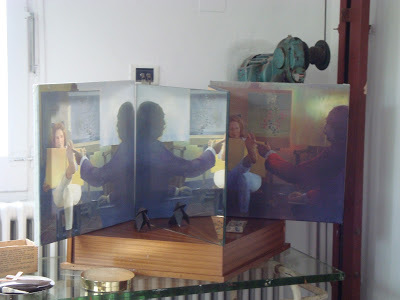 In Dalí's studio. Photo by Jessica KnaussI’d seen a lot of Dalí’s extraordinary art in museums in most of the countries I’d visited and was thrilled to be in a place that exuded his special brand of creativity, but when we moved past the library, through an anteroom with views onto the port, to the bedroom, Stanley asked a question that brought everything gloriously together for him: “Who slept in the other bed?”
In Dalí's studio. Photo by Jessica KnaussI’d seen a lot of Dalí’s extraordinary art in museums in most of the countries I’d visited and was thrilled to be in a place that exuded his special brand of creativity, but when we moved past the library, through an anteroom with views onto the port, to the bedroom, Stanley asked a question that brought everything gloriously together for him: “Who slept in the other bed?” 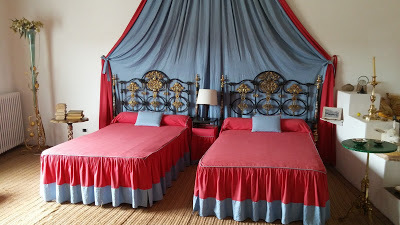 Gala and Dalí slept in the same room. Photo by Stanley CoombsIn spite of Dalí’s untraditional sexual practices, Gala made her mark throughout the house. Who was Gala? The love of Dalí’s life. The devotion between them was legendary and artistically fruitful. As soon as he could detect the love story, my husband sought out the special meanings of each room, which Gala and Dalí had built to their designs. All together we spent an hour and half there, wondering and wandering, but it was timeless, a romantic idyll, like all the moments we spent together.
Gala and Dalí slept in the same room. Photo by Stanley CoombsIn spite of Dalí’s untraditional sexual practices, Gala made her mark throughout the house. Who was Gala? The love of Dalí’s life. The devotion between them was legendary and artistically fruitful. As soon as he could detect the love story, my husband sought out the special meanings of each room, which Gala and Dalí had built to their designs. All together we spent an hour and half there, wondering and wandering, but it was timeless, a romantic idyll, like all the moments we spent together. 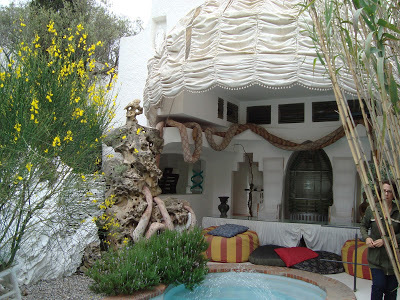 Photo by Jessica Knauss
Photo by Jessica Knauss
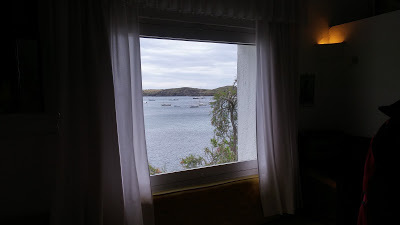 Photo by Stanley Coombs
Photo by Stanley Coombs
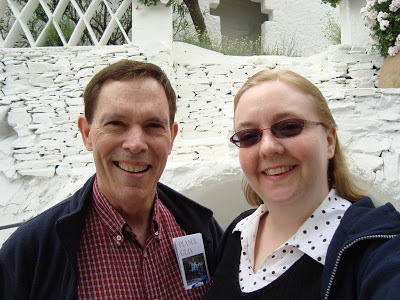 That smile was reserved for moments of true love. I’d heard about this house and read about it and seen travel shows about it, and I never honestly thought I would get to go there. Its location on the edge of the world felt out of reach to a lonely traveler. Obviously, I needed true love to get there.
That smile was reserved for moments of true love. I’d heard about this house and read about it and seen travel shows about it, and I never honestly thought I would get to go there. Its location on the edge of the world felt out of reach to a lonely traveler. Obviously, I needed true love to get there. 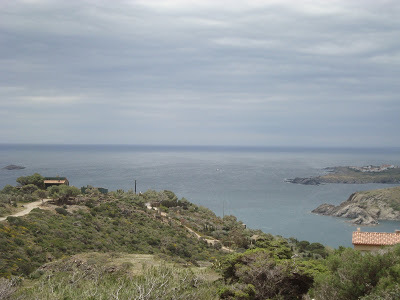 Darkening skies. Photo by Jessica Knauss The weather worsened—gale winds threatened to push the car off the road—and made it impossible for us to see the rock formations at the coast at Cap de Creus. As I mentioned, Cadaqués and Portlligat are on the edge of the world, so we had to drive back the way we’d come, through the twisting mountain roads. We were starving by the time we made it to Girona for lunch, but I had enough energy to appreciate it as it whizzed by our car windows while we searched for a place to eat. We finally parked in a garage and walked down Gran Avinguda Jaume I into a place called Viena, which, it turns out, has the best sandwich in the world according to the New York Times—a jamón on scratchy, crusty bread. We didn’t get that one; Stanley already had a pulverized hard palate from the hard bread we’d been eating. We ordered hamburgers with bacon and egg and pepper sauce, with some fries and the most satisfying drink in the world according to my love, Fanta taronja (Catalan for orange). The buns were as hard as any baguette! It’s not easy to eat a hamburger in solid steel casing. But I thought it was really good, anyway. I was relieved to find they’re a Catalan company and in Catalan tradition, they had a lot of lovely pastries for breakfast. And Girona became another place I thought I would like to live.
Darkening skies. Photo by Jessica Knauss The weather worsened—gale winds threatened to push the car off the road—and made it impossible for us to see the rock formations at the coast at Cap de Creus. As I mentioned, Cadaqués and Portlligat are on the edge of the world, so we had to drive back the way we’d come, through the twisting mountain roads. We were starving by the time we made it to Girona for lunch, but I had enough energy to appreciate it as it whizzed by our car windows while we searched for a place to eat. We finally parked in a garage and walked down Gran Avinguda Jaume I into a place called Viena, which, it turns out, has the best sandwich in the world according to the New York Times—a jamón on scratchy, crusty bread. We didn’t get that one; Stanley already had a pulverized hard palate from the hard bread we’d been eating. We ordered hamburgers with bacon and egg and pepper sauce, with some fries and the most satisfying drink in the world according to my love, Fanta taronja (Catalan for orange). The buns were as hard as any baguette! It’s not easy to eat a hamburger in solid steel casing. But I thought it was really good, anyway. I was relieved to find they’re a Catalan company and in Catalan tradition, they had a lot of lovely pastries for breakfast. And Girona became another place I thought I would like to live. 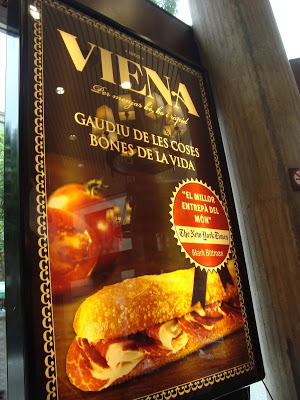 "Enjoy the good things in life"
"Enjoy the good things in life" "The best sandwich in the world—The New York Times"
Slogans are even better in Catalan (says this linguist)The hugeness of Barcelona struck us both. Our hotel was in the middle of a commercial-industrial area in Cornellà de Llobregat, but we took a walk and saw a Manolo poster for a concert he’d already given. Had we heard anything from him yet? "Not yet," we said, with love and hope in our hearts.
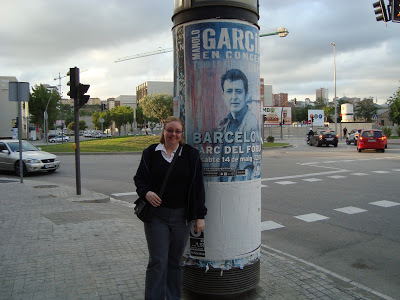 Portents of things to come...
Portents of things to come...Photo by Stanley Coombs
It’s more tiring than you think it will be when you haven’t been somewhere before. I’d been in Barcelona long before, but it was a package tour—no thinking required. Next time: I try to navigate Barcelona on my own for the first time!
Catch up with the rest of the posts in this series here.
Published on May 29, 2017 00:30
May 26, 2017
The Cradle of Catalunya: The Trip of a Lifetime, Part 5
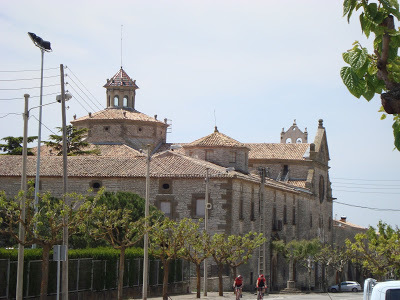 A palace near the gas station in Sant Ramon, because it's Catalunya
A palace near the gas station in Sant Ramon, because it's CatalunyaPhoto by Jessica Knauss On the morning of May 18, 2016, my husband and I were overjoyed to eat the hotel breakfast because it included "Macedonia" yogurt. Macedonia is a special mixed fruit flavor I had to work hard to convince Stanley to try in 2015. From the moment it hit his tongue, it was the only flavor of yogurt he ever wanted to eat, and you can’t get it in the United States.
It was a cloudy day, but we were too cheerful to let it bother us. The previous day was only the second time I’d been in Aragón, and that day was going to be the second time I’d been in Catalunya. The regions of Spain are a source of constant cultural and linguistic amazement.
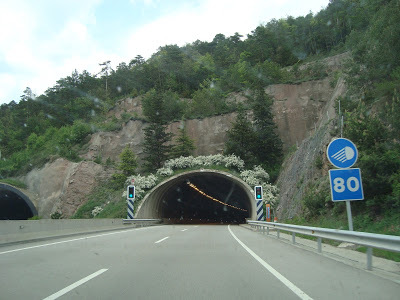 The mountain tunnels are decorated with flowers.
The mountain tunnels are decorated with flowers.Photo by Jessica Knauss It was a long drive to Ripoll, but with all the charms of castles on crags, changing landscapes, an arch that showed the Greenwich Line (opposite the International Date Line), and tons of tunnels through the mountains. We stopped at a gas station in a little place called Sant Ramon, which had a big palace. We bought a large bottle of water for only one Euro and the guy was helpful, conversing in Spanish, but the bathroom keys’ labels read dones and homes, the Catalan words for “women” and “men.” The linguist in me came out to celebrate, not to retreat for the rest of the journey.
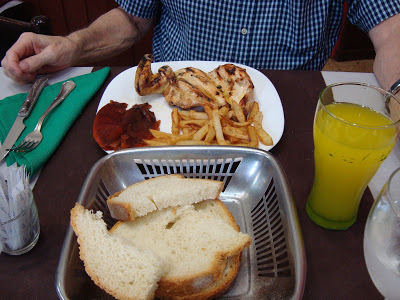
The first droplets of water hit us on our entry into Ripoll, a place with lots of garden centers and a few shops. We went to Restaurant Can Villaura for lunch at a quarter to four, when the crowd was thinning out. I got a menu in Spanish to cope with ordering, but was reading all the Catalan on the walls. We had macarrones with gratinado and roasted chicken and fries. Roasted chicken with delicately seasoned sauce and potatoes fried in olive oil had become Stanley’s favorite dish in 2015 and if it was on offer, we couldn’t let it pass by. As soon as we stepped out of the restaurant, it started pouring insanely cold rain.
We ran under a pedestrian bridge, and the prospect of waiting for the cloudburst to pass was unattractive because neither of us had our jackets. Stanley ducked out and ran to the car to retrieve my jacket for me. It got soaked and he was frozen, but the gallantry was not lost on me. I used it as an umbrella to get to the car, where we sat in the blast from the heater for some minutes while it pelted rain.
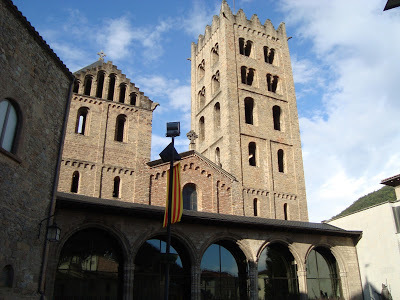 The monastery at Ripoll after the rain
The monastery at Ripoll after the rainPhoto by Jessica Knauss When the rain became normal enough, we drove to the monastery, arriving around 5 p.m. We were all by ourselves in the explanatory chapel in the tourism office and I was overwhelmed with the importance of this place to Catalan history. It all happened here!
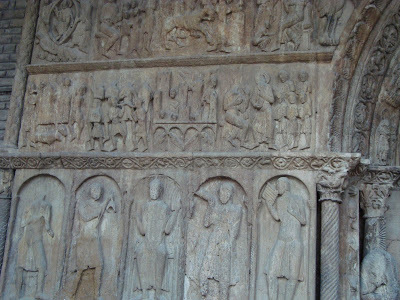 Small section of the main portal at Ripoll
Small section of the main portal at RipollPhoto by Jessica Knauss The main portal at Ripoll is touted as the finest example of Catalan Romanesque sculpture. Nothing I’d read about it prepared me for how astounding it was. The photos don’t do it justice, of course. Stanley helped me record every inch of the wonder and kept me on schedule so we could see it all before they closed. The interior of the monastery had artistic contributions from the early Middle Ages to the present, and I stood, paced, and gasped, puzzling it all out in Catalan, Spanish, and English. I’m not sure how to convey the joy when I discovered that the cloister had a different capital on every marble column.
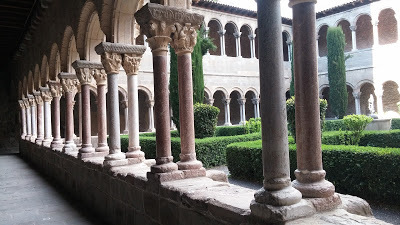 The cloister at Ripoll
The cloister at RipollPhoto by Stanley Coombs It was a two-hour drive to Cadaqués. The map made it look close from Ripoll, but it wasn’t detailed enough to show all the mountainous switchbacks and curves. I thought we’d come out of the mountains to get to the coast, but that coast is rugged and hilly. Cadaqués is all hills, some of them so steep Stanley held onto me so I wouldn’t slide down.
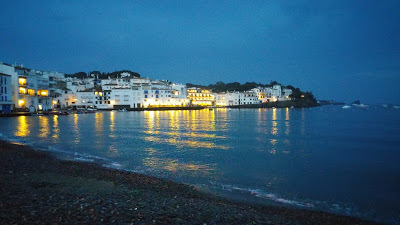 Cadaqués at night
Cadaqués at nightPhoto by Stanley Coombs We didn’t arrive until nightfall, around 9 p.m. The hotel was basic, but it was almost more comfortable that way. A five-star luxury experience could’ve been too much in such an ecstatically charming location. We walked out in the dark and the drizzle to look for dinner. We made it to the shore, with the waves crashing, restaurants, and a Dalí statue, then turned around and bought a pizza (they call them cocas) and a crispy almond honey flatbread about as big as a 33 rpm record at a bakery and ate them with peanut butter crackers back in the room. The prevailing feeling was that we should stay longer, but alas, I’d scheduled only one night there.
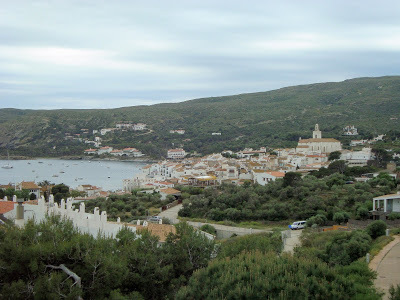 Cadaqués in the morning
Cadaqués in the morningPhoto by Jessica Knauss
Next time: the romantic frenzy of Salvador Dalí and Gala.
Catch up with the rest of the posts in this series here.
Published on May 26, 2017 00:30
May 24, 2017
Emails and Osbourne Bulls: The Trip of a Lifetime, Part 4
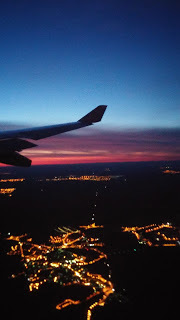 Arriving in the early morning.
Arriving in the early morning.Photo by Jessica Knauss My husband and I were diehard Manolo García fans, and in spite of a severe lack of cash that saw us in Arizona, hunched on folding chairs in a one-room apartment with little other furniture, we purchased his 2011 album, Los días intactos . Through the wonders of the internet, we heard the brilliant new songs the same day the Spanish did. But there was no way we could consider going to Spain for the million-city, small-venue tour for that album.
In 2014, on the other hand, I had been working a regular job for some time. When Manolo García released the latest of his mind-blowingly great albums, Todo es ahora , we were able to listen for the first time together on real furniture in Massachusetts. Because it had been so long since our honeymoon in Spain (in 2009), we decided we would head over for that concert tour. I would finally see Manolo García live and fulfill my lifelong dream, which had been so thoughtlessly obliterated in 2008.
Being an authentic artist, Manolo can’t be rushed. Instead of launching the 2014 album with a tour, he went back to the studio with his buddies and made a five-disc collection of gorgeously remastered and re-recorded old gems, which of course I snapped up with glee. We waited, but it didn’t look like a tour was forthcoming, so in March 2015, Stanley and I went to Spain for the second time together and had a grand, mostly medieval time. We spent most of the ten days in Seven Noble Knights territory, so it was fitting that the day of our return, I was surprised with an email in which Bagwyn Books accepted it for publication.
Later that year, concert dates were published. We conferred briefly and my sweet, wise husband said we should take this opportunity because it doesn’t come around often. I think, empathic soul that he was, he sensed the giant hole in my existence because I had never been to a Manolo García performance. We investigated the concert venues, and they were all enormous, which felt overwhelming to our sensitive introversion. We chose to see Manolo García at the bullring in Valencia because the venue had the smallest capacity. I had never been to Valencia, though I’d always wanted to.
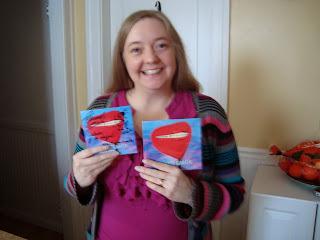 Ecstatic in 2014 with an unexpectedly signed copy of Todo es ahora
Ecstatic in 2014 with an unexpectedly signed copy of Todo es ahora Photo by Stanley Coombs When the tickets went on sale, I jumped on them like the lifeline they were. Eighty Euros apiece gave us admission to a dream come true. I ceded the desk chair to Stanley and he strategized our plane tickets with memberships and miles, and I leaned over his shoulder to help him choose a rental car. Between the purchase of those tickets and the time we would use them, we moved from Massachusetts back to Arizona, so it was quite the geographic brain twister to arrange.
Two days before our flights, on a bright Arizona May 14, I awoke to an email. (My translation follows.)
Hi Jessica,
Are you there? Is this your email? I’m Manolo García. I received your letter and know about the unexpected events you had when traveling.
Please answer and tell me if you both are coming to the concert in Valencia.
A hug from this sinner of the prairie [a cultural reference too complex to explain here], who is,
Manuel García.
My head exploding, I checked the from address and verified that it was coming from Carmen. Not just any Carmen, but a talented and creative Spanish music artist who happens to be Manolo García’s sister.
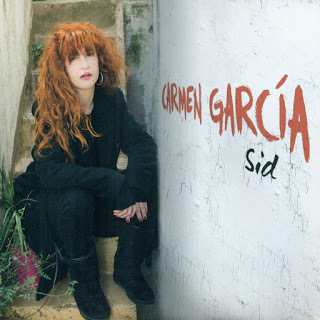
Only when I was half convinced of the message’s legitimacy did I call Stanley in to see. Are there words to describe what it’s like to be contacted by Carmen on behalf of Manolo García? Not really. That day still stands out as unique. Stanley came up with a lot of scenarios, but I focused on accepting that this was enough, that even if we never heard anything from them again, we would still love Manolo and Carmen for all the joy they’d already brought us. We composed a message in reply and checked every time we could as we traveled to see if someone wrote back. Not yet, not yet, we kept saying.
Stanley and I always divided up the labor of a journey in a way that maximized the use of each other’s talents and made for the smoothest journey. I took care of everything on Spanish soil except the rental car, and Stanley assumed responsibility for all transportation, including how to behave at the airport to get the best service. I was happy to comply with any suggestion he had because the result was always magical.
We had some concern about making a connection at the Charlotte airport, and it turned out that even though it’s manageable in size, we arrived at the gate only eleven minutes before boarding. It felt like one more charm in a series of charmed events. For example, our tickets put us into the TSA precheck line. The flight felt long, mostly because it was on one of those fancy airplanes that pressurizes the cabin to almost normal altitude, and when there’s more oxygen it’s harder for me to fall asleep.
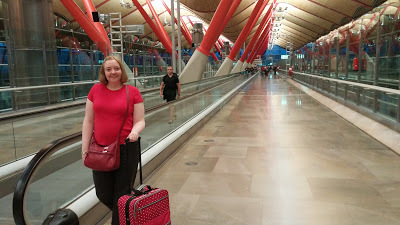 T4 at Aeropuerto Adolfo Suárez Madrid-Barajas
T4 at Aeropuerto Adolfo Suárez Madrid-BarajasPhoto by Stanley Coombs We arrived on May 17. Oh, the exhaustion! Oh, the crustiness! We knew the drill about the rental car from the previous year. It was a tiny black SEAT no one would ever want to steal. Then we went back up the flat escalator for carts, and ate donuts and a paleta de ibérico sandwich with orange Fanta. That was several things off the list already.
We had no trouble finding where to go, even though it was tough booting up Susie, which is what we called our phone GPS navigator, in a "foreign" country. The landscape changed dramatically every few kilometers, and we passed into Castilla-La Mancha, Castilla y León, and Aragón. We saw tons of iconic Osbourne bulls.
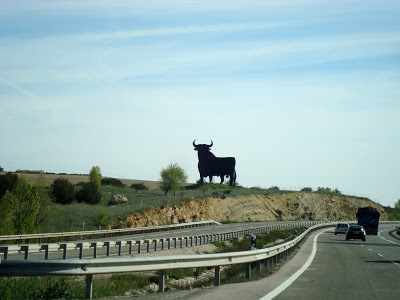 You won't see these wordless liquor ads anywhere but Spain.
You won't see these wordless liquor ads anywhere but Spain.Photo by Jessica Knauss When we caught a glimpse of Medinaceli, which is mentioned in Seven Noble Knights , we stopped and marveled. It turned out to be one of the pueblos más bonitos de España. Yes, this is a thing. Spain officially chooses its most beautiful towns. Next, Calatayud was amazing with thirteenth-century churches and a million castles, but we couldn’t get to any of them in the car, and were too tired to walk. Stanley did some amazing maneuvers on the small streets in that car. There was a statue of Alfonso el Batallador (notorious husband of Queen Urraca) tucked into a corner we swept by.
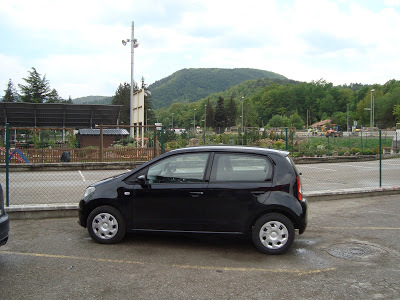 Our SEAT for two weeks.
Our SEAT for two weeks.Photo by Jessica Knauss
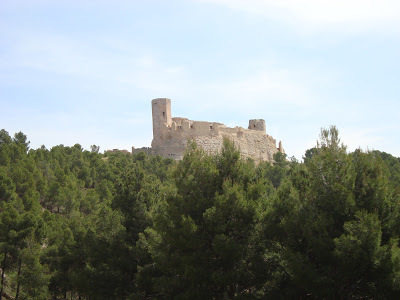 Calatayud
CalatayudPhoto by Jessica Knauss When I was telling family and friends about this journey afterward, Stanley would contribute a story about when I was trying to get the above photo in Calatayud. Stanley didn't even want me to have to get out of the car—that's how tired were were—and, still getting used to the stick shift, he backed into a random invisible concrete block and scuffed the back right bumper. He was concerned that the rental company would charge us for the damage and started hatching a plan to avoid that.
Our hotel in Zaragoza was in the middle of a big commercial area with trucks and malls. We had trouble finding somewhere to eat and ended up at McDonald’s. That must've been a direct result of my dad, because when he called me while we were on the way to the Phoenix airport, he asked if we were going to eat McDonald’s in Spain. As if Spain weren’t one of the best food countries in the world. But this McDonald's wasn't like any I'd been to in the United States. It had a fancy electronic ordering system, and I ate deluxe fries with curry sauce.
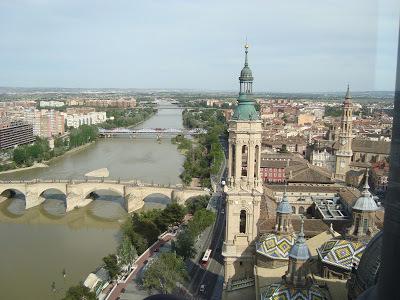 The Ebro, the signature roof tiles of the Basílica del Pilar, and lovely Zaragoza
The Ebro, the signature roof tiles of the Basílica del Pilar, and lovely ZaragozaPhoto by Jessica Knauss We slept for an hour and a half and drowsed a little more before resolving to go to Zaragoza's famous basilica. This place is the reason so many Spanish ladies are named Pilar. We went to the top of the tower with the help (but not all the way) of the attended elevator. Amazing views of the Ebro, the biggest river in Spain. We walked around in the Pilar plaza a little, and when we saw a pharmacy, we got Stanley an expectorant because he thought he had either bronchitis or Valley Fever. Then we had gorgeous lemon and chocolate/crema catalana gelato and got back in the car to take a Susie-led tour of Zaragoza’s posh shopping streets and the places only the locals go. It was so attractive, I thought I wouldn’t mind living there. We ended up at the palace, but it was so late in the day we didn't have time to go in. It’s huge! We strolled around it and enjoyed the gardens with the locals at the end of the day.
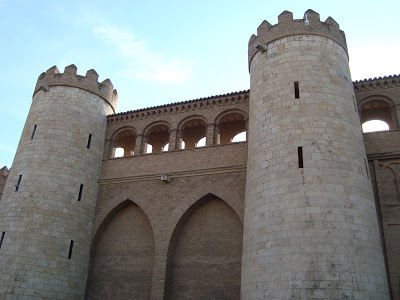 Palacio de la Aljafería, Zaragoza
Palacio de la Aljafería, ZaragozaPhoto by Jessica Knauss At that point, we headed for a big mall anchored by Hipercor (one of Spain's Walmart approximations) and shopped for detergent, hand lotion, shaving cream, black shoe polish to "repair" the car, and candy. We had dinner there at a local joint, sharing a menú of esparragos blancos with jamón serrano and a scrumptious bistec with pepper sauce. Natillas for dessert—yum!
After a day that lasted about 48 hours, we slept well.
Next time, a romantically rainy day in Catalunya.
Published on May 24, 2017 00:30
May 22, 2017
"I think I was robbed": The Trip of a Lifetime, Part 3
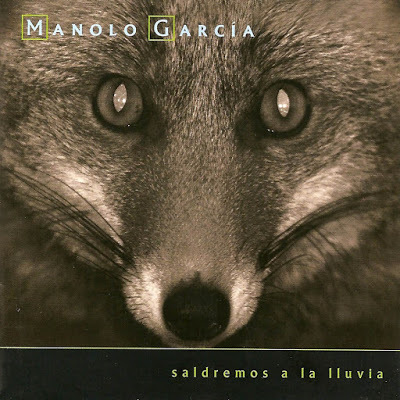 Although I've loved Manolo García since 1995, I had never seen him live. It was a matter of not believing I deserved to experience even a moment of the happiness a Manolo García concert would surely provide. In 1995, 1998, and 2005, I had opportunities involving varying degrees of difficulty and expense, and seized exactly zero of them.
Although I've loved Manolo García since 1995, I had never seen him live. It was a matter of not believing I deserved to experience even a moment of the happiness a Manolo García concert would surely provide. In 1995, 1998, and 2005, I had opportunities involving varying degrees of difficulty and expense, and seized exactly zero of them. As I wrote last time, the summer of 2008 was already a huge deal because I moved in with the love of my life, and in August I was finally going to a Manolo García concert as well! It was part of the tour for his fourth solo album, Saldremos a la lluvia . In order to afford the airfare, I had to save money for months ahead of time, when I had only odd jobs. Stanley’s acceptance and encouragement of this crazy trip meant the world to me. It was only for the weekend, Friday to Tuesday, and the cost was something like a hundred dollars per hour that I would be on Spanish soil, but Stanley understood that this would fulfill a life’s dream for me and regarded it with utmost respect. He couldn’t come with me only because we had just spent so much money moving.
My visits to Spain had never focused on Madrid. It was a mere stopover on the way back to the States, or on to other, more quintessentially Spanish regions.
I made my way quickly from the airport to the train station, having honed my navigation skills on seven previous trips. I waited in line for an hour to buy my ticket to Ciudad Real, the city where the concert would take place. Then, instead of stopping to eat, I called Stanley from a bank of phones, because I knew he would want to know I was safe and on my way.
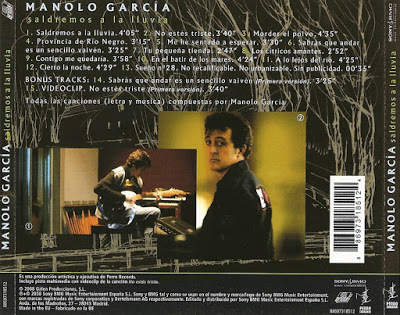
I learned immediately upon hanging up that it doesn’t do to get so comfortable in the biggest train station in Spain that you drop your guard, even for a second. When I turned away from the phone bank, back to my rolled luggage, my purse was not where I had left it. I stood, astounded, and a fellow traveler started making signs as if to ask whether he could use the phone.
“Creo que me robaron” (I think I was robbed), I said, unable to believe it.
“¿Que te han robado?” (You’ve been robbed?), he replied in surprise. He kindly led me to the security guards, starting a long afternoon. It was Friday, and a holiday—the feast of the Assumption of the Virgin Mary—so I had to search the neighborhood for a police station that was open in order to report the theft, darting here and there, sweating copiously in Madrid in August with my rolled luggage, and stopping to ask people directions every so often. With the purse, I had lost American and European cash, credit cards, the train ticket I’d just purchased, a digital camera Stanley had leant me, as well as my passport and all my other forms of ID. At the police station, I learned that you cannot have money sent to Spain from the United States without a proper ID.
By the time I’d made my declaration, the time for the train for Ciudad Real had come and gone. I still hadn’t eaten, and I had hotel reservations in Ciudad Real, but no way to get there. I had Spanish friends, but they were all outside Madrid and I hadn’t brought their phone numbers with me, anyway, since it had been planned as such a short trip. It was looking as though I would have to sleep in the train station and beg for crumbs until the American Embassy opened on Monday so I could replace my passport.
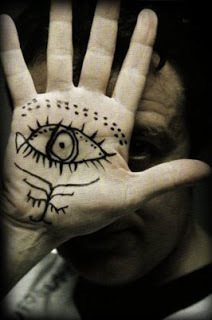
I refused to surrender to panic, and eventually, after I’d insisted enough about how destitute I was, the police called social services. Two pleasant young Spaniards—fans of Manolo García, no less—came to deposit me in a Good Samaritan house, where I could sleep in a shared room, take public showers, and eat terrible food, all at no charge. Grateful as I was, all I could do was wait and try not to think of all my ruined plans.
Each time I had come to Madrid previously, it had struck me as a hulking modern behemoth: overwhelming, busy, and not open to enjoyment. This was in spite of my programmed tours of the typical tourist destinations. This time, without a Euro cent to my name, I couldn’t spend money on goods or attractions, and so I would have expected to enjoy Madrid even less than before. But without the distractions of timetables and costs, I could focus instead on learning the streets on foot. I took advantage of churches with free admission for something to do, and since I couldn’t even take pictures, I found myself becoming much more present and receptive, observing and experiencing the life—people, birds, plants, art—around me. I fell in love with Madrid in the purity of those three days.
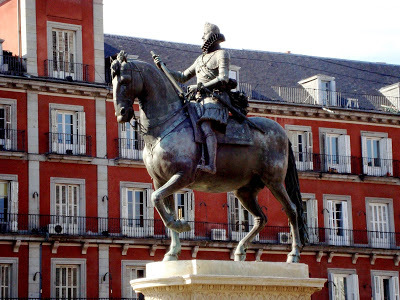 Photo by Jessica Knauss I got to speak with Stanley on the phone twice, for about three minutes at a time, as I milked the last minutes out of the calling card I’d brought from the States. Overall, I think he had a worse weekend than I did, worrying about my safety and comfort.
Photo by Jessica Knauss I got to speak with Stanley on the phone twice, for about three minutes at a time, as I milked the last minutes out of the calling card I’d brought from the States. Overall, I think he had a worse weekend than I did, worrying about my safety and comfort. In the Good Samaritan house, I viewed a Star Wars marathon dubbed in Spanish because of a ten o’clock curfew. From the balcony, I watched parades and festivities in honor of the Assumption of the Virgin Mary in the street. I got to observe all manner of people passing through the residence, and I helped some of them by interpreting between them and the staff. Perhaps most importantly, I got to read a gift from Stanley, Eckhart Tolle’s The Power of Now , which had been in my rolled luggage. Without that book’s sane perspective, I would’ve had a completely different experience.
What was really important? I was safe and I had my future husband’s love and support, albeit from afar. This confluence of events taught me to accept things as they are. Wishing they were different would only have made me miserable, since there was nothing I could do to change the situation.
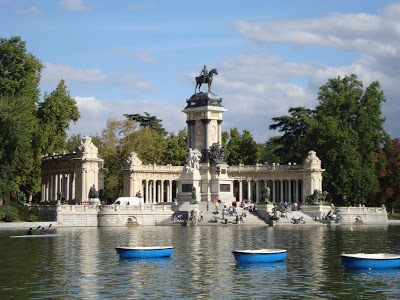 Photo by Jessica Knauss Monday rolled around, and using the subway fare the Good Samaritan house had given me, I got to hang out at the American Embassy. With my new passport, Stanley was able to send me money, and I stayed in the Madrid hotel I had reserved from home, before leaving for the States, as planned, on Tuesday. Iberia upgraded me to first class at no charge, as if they somehow knew I hadn’t been able to live my dream and wanted to compensate.
Photo by Jessica Knauss Monday rolled around, and using the subway fare the Good Samaritan house had given me, I got to hang out at the American Embassy. With my new passport, Stanley was able to send me money, and I stayed in the Madrid hotel I had reserved from home, before leaving for the States, as planned, on Tuesday. Iberia upgraded me to first class at no charge, as if they somehow knew I hadn’t been able to live my dream and wanted to compensate. I still hadn’t seen Manolo García in concert. But there are worse things than being temporarily stranded and penniless in Madrid, as I have come to understand. Stanley thought I should let Manolo know what had happened, so I wrote a letter. Nearly a year later, Manolo responded with a beautiful watercolor with his signature and a personal note (with my name, lower left) thanking me for my efforts. If I wanted to come back to Spain (he thought so), I should let him know. I’d earned a coffee, or a beer, or whatever I wanted, with “un amigo.” He was referring to himself! What a great guy!
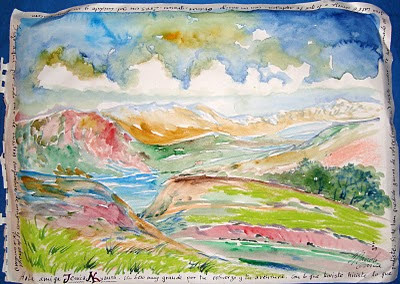 Art by M. García; photo by Jessica Knauss A few months after that, I returned to Madrid with my new husband on our honeymoon. We didn’t call up Manolo because we were still astounded that he’d responded at all, never mind so nicely, and couldn't conscience taking advantage, but we spent a couple of enchanted days in the capital of Spain. I was able to show Stanley around all the better for the crazy experience the previous year, and I’m sure it helped to convert him into almost as big a Spain fan as I am. Eventually, we returned to Spain together twice. Such a glorious times with the man I love most in the most magical place.
Art by M. García; photo by Jessica Knauss A few months after that, I returned to Madrid with my new husband on our honeymoon. We didn’t call up Manolo because we were still astounded that he’d responded at all, never mind so nicely, and couldn't conscience taking advantage, but we spent a couple of enchanted days in the capital of Spain. I was able to show Stanley around all the better for the crazy experience the previous year, and I’m sure it helped to convert him into almost as big a Spain fan as I am. Eventually, we returned to Spain together twice. Such a glorious times with the man I love most in the most magical place. I first wrote about my cutpurse adventure on the occasion of our first wedding anniversary:
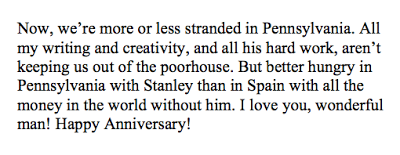
Our marriage was relentlessly tested with threats of poverty. As you can see, we were happy anyway. At least in part because of that disastrous 2008 trip to see Manolo, we appreciated what we had while we had it. Non, je ne regrette rien.
After that, Stanley and I were never apart if we could help it. The passionate love we started with matured quickly into devotion forever. The small details of day-to-day care and kindness were already apparent in this short, fraught time we were apart.
And so Manolo García provides the first bookend. This story of happiness continues in the next posts with our decision to return to Spain in 2016 and a short communiqué from one Sr. García.
Published on May 22, 2017 00:30
May 19, 2017
Road Trip Music: The Trip of a Lifetime, Part 2

In July 2008, I moved in with Stanley, who would become my husband the following year. In order to bring the small number of items he treasured from where he’d been living in Idaho to Massachusetts, we did our first cross-country road trip together in his Honda Accord and had nothing but fun. We stopped and explored or ate or rested whenever we wanted to, and I’d brought a bunch of CDs (remember those?) for our road trip soundtrack.
Everything I’d played for him up to that point had been music I loved, and he’d loved it, too. But I was still nervous to stick in the Manolo García CD. His fourth solo album, Saldremos a la lluvia , was pretty unusual, with Greek instruments and environmental lyrics in Spanish. My previous relationship had scarred me when the man in question couldn’t tolerate listening to Manolo García because he couldn’t understand what he was singing about. (I’ll note that as a giant red flag if I ever date again!)
“This disc is really important to me. This is the artist I love most in the world,” I said. “It’s okay if you don’t like it. I’ll take it out and we never have to hear it again together, but if you don’t like it, please be kind.” Asking Stanley to be kind was like asking a flower to bloom, but it was still early days. He acknowledged my request, and after the first song, I stared at him to gauge his reaction.
“It’s nice,” he said. “Leave it in.” Not the jumping for joy I could’ve hoped for, but the response still flooded me with relief. We listened to the whole disc attentively, and when we’d gone through all the other discs, Stanley did the most wonderful thing: he requested Manolo García again!
Thus I won my husband over for the Manolo García cause. Or rather, Manolo's awesomeness won Stanley over. Eventually, I made an mp3 disc with Manolo’s entire solo works for listening in the car, and one day we realized that it was all we ever listened to. When the nine hours finished, it cycled back to the beginning. When we realized this, we traded the disc for Lily Allen, whom we had seen together in concert in Boston. But as wonderful as she is, it felt wrong (Stanley's word, not mine!) to have anyone but Manolo in the CD player. So back in Manolo went.
Sometimes when getting out of the car, we would say, “Bye, Manolo!” We might measure a trip by how many Manolo albums it took to get there. Once we visited Tumacácori, a lovely Spanish mission so close to Arizona's border with Mexico that we passed through a checkpoint on I-10. I turned off the music so the officers wouldn't hear Spanish coming out of our speakers. "That was a good idea," said Stanley. What a world! I hope that's the only time it's a good idea to turn off Manolo music.
Stanley would ask me what some of the songs were about, and some, he informed me, were love songs. “No, it’s love gone wrong,” I would say, or, “Yes, a love song to the city of Cádiz…” No matter the real lyrics, to my husband—an inveterate romantic, at least as soon as he met me—they were all love songs. They accompanied us through life like a faithful friend.
The above song was Stanley's favorite for years. I'm not sure he liked the video much, though.
Tune in next time for the unexpected outcome of my 2008 journey to Spain and how it laid the basis for a wonderful marriage.
Published on May 19, 2017 00:30
May 17, 2017
Three Brown-Haired Loves: The Trip of a Lifetime, Part 1
Three men, all brown-haired, brown-eyed, and handsome down to their souls, have received my lifelong devotion. One is Alfonso X, el Sabio, whom I “met” in 1995, 711 years after he died. The most important is my husband, Stanley, who, as you probably know, passed away in July 2016. Last summer, I lived a lifetime of lows—and highs. Stanley left the world suddenly, and only two months before, we experienced the best two weeks of a marriage that had already doubled the world’s happiness quotient.
I’ve been learning about the therapeutic uses of writing about happy times, so I'm going to turn this blog into a travel narrative of those awesome two weeks in in Spain in May 2016. I have to lay the groundwork with yet more happy things, namely my third love, Manolo García.
Who?
If I had a dollar for every unit of how much I love Manolo García, a lot of people would never have to worry about money. My family would be set forever. Several universities and millions of hungry people would benefit from my love of Manolo García as much as I do, and the cycle would continue. Yes, Manolo García is the key to world peace and full bellies.
He’s primarily a musician, with an illustrious career on the Spanish pop scene. I love his melodies and his voice, and of course, that mysterious alchemy when he was making music with Quimi Portet. The writer in me appreciates his surrealist, poetic lyrics. They come from pure inspiration. They either make no sense at all or they make perfect sense. Below is my translation of the song that makes the most sense to me.
“Rosa de Alejandría” Nunca el tiempo es perdido (2000)
Rose of Alexandria, yellow rose.
I want to get away. To go deep into silence.
I want to get away
from this life I live unconvinced,
and delve into the time of lights,
raw clay jars lit by the hand of the mysterious potter.
I want to get away. Go deep into silence.
Walk calmly. Abandon this path.
I want to get away.
Make a nest in the eaves
with the blue-feathered swallows.
Become a measuring cup for bushels, liters, gallons,
be wheat on the threshing floor,
never dust on the pavement.
Rose of Alexandria, yellow rose.
Today you must be my guide, the shining light.
Midday lighthouse, simple rose
Rose of Alexandria, yellow rose.
With flowers in a flaming field
like a Saint Francis [of Assisi], I live among the thickets
crawling with lizards.
I feed on chimeras
and content myself with simple things.
Maidens with smiling faces find me at peace,
like a perfect Góngora [poet of sixteenth- and seventeenth- century Córdoba, complex imagery, revolutionized the Baroque style, longing for the peace of the countryside]
surviving far from the hubbub.
With my yellow rose, with my rose from the precipices.
I want to get away. Go deep into silence.
I want to get away. Abandon this path.
I want to get away.
Rose of Alexandria, yellow rose.
Today you must be my guide, path between islands.
Midday lighthouse, simple rose.
Rose of Alexandria, yellow rose.
His more recent work has been a lot less angst-ridden, but no less beautiful. Manolo García is a huge influence on me and my writing, because I try to tap into that mystical place of creation he so clearly accesses with his words and look for the most beautiful images, the ones that would make him proud.
Also he's a wonderful person and loves living creatures. But those are matters for the coming posts, in which I will describe how the great Manolo García bookended my magnificent married life with Stanley, and our stunning last trip to my beloved Spain, complete with photos and videos.
I’ve been learning about the therapeutic uses of writing about happy times, so I'm going to turn this blog into a travel narrative of those awesome two weeks in in Spain in May 2016. I have to lay the groundwork with yet more happy things, namely my third love, Manolo García.
Who?
If I had a dollar for every unit of how much I love Manolo García, a lot of people would never have to worry about money. My family would be set forever. Several universities and millions of hungry people would benefit from my love of Manolo García as much as I do, and the cycle would continue. Yes, Manolo García is the key to world peace and full bellies.
He’s primarily a musician, with an illustrious career on the Spanish pop scene. I love his melodies and his voice, and of course, that mysterious alchemy when he was making music with Quimi Portet. The writer in me appreciates his surrealist, poetic lyrics. They come from pure inspiration. They either make no sense at all or they make perfect sense. Below is my translation of the song that makes the most sense to me.
“Rosa de Alejandría” Nunca el tiempo es perdido (2000)
Rose of Alexandria, yellow rose.
I want to get away. To go deep into silence.
I want to get away
from this life I live unconvinced,
and delve into the time of lights,
raw clay jars lit by the hand of the mysterious potter.
I want to get away. Go deep into silence.
Walk calmly. Abandon this path.
I want to get away.
Make a nest in the eaves
with the blue-feathered swallows.
Become a measuring cup for bushels, liters, gallons,
be wheat on the threshing floor,
never dust on the pavement.
Rose of Alexandria, yellow rose.
Today you must be my guide, the shining light.
Midday lighthouse, simple rose
Rose of Alexandria, yellow rose.
With flowers in a flaming field
like a Saint Francis [of Assisi], I live among the thickets
crawling with lizards.
I feed on chimeras
and content myself with simple things.
Maidens with smiling faces find me at peace,
like a perfect Góngora [poet of sixteenth- and seventeenth- century Córdoba, complex imagery, revolutionized the Baroque style, longing for the peace of the countryside]
surviving far from the hubbub.
With my yellow rose, with my rose from the precipices.
I want to get away. Go deep into silence.
I want to get away. Abandon this path.
I want to get away.
Rose of Alexandria, yellow rose.
Today you must be my guide, path between islands.
Midday lighthouse, simple rose.
Rose of Alexandria, yellow rose.
His more recent work has been a lot less angst-ridden, but no less beautiful. Manolo García is a huge influence on me and my writing, because I try to tap into that mystical place of creation he so clearly accesses with his words and look for the most beautiful images, the ones that would make him proud.
Also he's a wonderful person and loves living creatures. But those are matters for the coming posts, in which I will describe how the great Manolo García bookended my magnificent married life with Stanley, and our stunning last trip to my beloved Spain, complete with photos and videos.
Published on May 17, 2017 00:30



